What Does It Mean to Be a “Bottom” or “Submissive” in Lesbian Sex?
Like so many elements of queer culture, nailing down the terms “top” and “bottom” are harder than you might think. Whether you’re perusing queer personals, swiping on Tinder or talking to your friends at an inappropriate volume in a public park; it seems like many LGBTQ women and/or trans folks are eager as beavers to identify as a bottom, top or switch. But as many moviegoers may be wondering this weekend after seeing the film Bottoms — what does it mean to be a bottom? What is the meaning of submissive? Well luckily we have unearthed this post from 2018 to get you back into the realm of knowledge on this topic.
![]()
The Tops, Bottoms And Switches Sex Survey
Here’s the results from a survey we conducted about these slippery words, for which over 3.6k people showed up to share their tops and bottoms with me. These are the demographics of the respondents:

right-click to open and enlarge
![]()
How Many Bottoms Are Out There?

Tops: 12% // Bottoms: 14.3% // Switch: 51.6% // None of the Above: 13.4% // I’m Not Sure: 8.9%
Although these terms/identities seem popular and ubiquitous, our survey revealed that people who identify specifically as tops or bottoms are in the minority overall.
There were also some interesting delineation around trans status — 36% of trans women identify as bottoms, compared to just 14% of cis women and 11% of non-binary or agender people.
What Does It Mean To Be A Bottom?
Before our culture adopted top/bottom as terminology relevant to non-kinky sex, the terms were primarily used by gay men or in kink or BDSM contexts by both straight and LGBTQ+ people.
Survey responses suggested that there are three distinct approaches to these terms from queer women, trans men and non-binary people:
- “Bottom” as an identity relevant to non-kinky sex;
- “Bottom” as a concept relevant to kinky sex, distinct from “submissive”;
- “Bottom” and “submissive” as interchangeable concepts within kinky sex.
Now that we know there’s literally no way to define any of those words in a way that speaks to everybody’s experiences, let’s try to do ti anyway!
![]()
What Do Bottoms Like To Do In Bed?
We asked survey-takers to indicate their passion for giving and receiving a variety of sexual acts, and also asked them to define what “bottom” means to them. We’ve included some of the most popular activities below. (Note that scissoring / dry-humping was not included on the survey as it has no clear giving/receiving dynamics.)
The penetration-related activities mentioned in the below graphic involve fingers and strap-ons because they were the acts most statistically numerous in our survey results, but of course other kinds of penetrative sex exist for cis and trans women, non-binary people and trans men, including penetration with toys or with penises, and those activities are enjoyed by many bottoms of all kinds.
While bottoms expressed a similar level of interest in giving external stimulation as they are in getting it, there was a distinct preference for receiving when it came to all penetration-related activities.
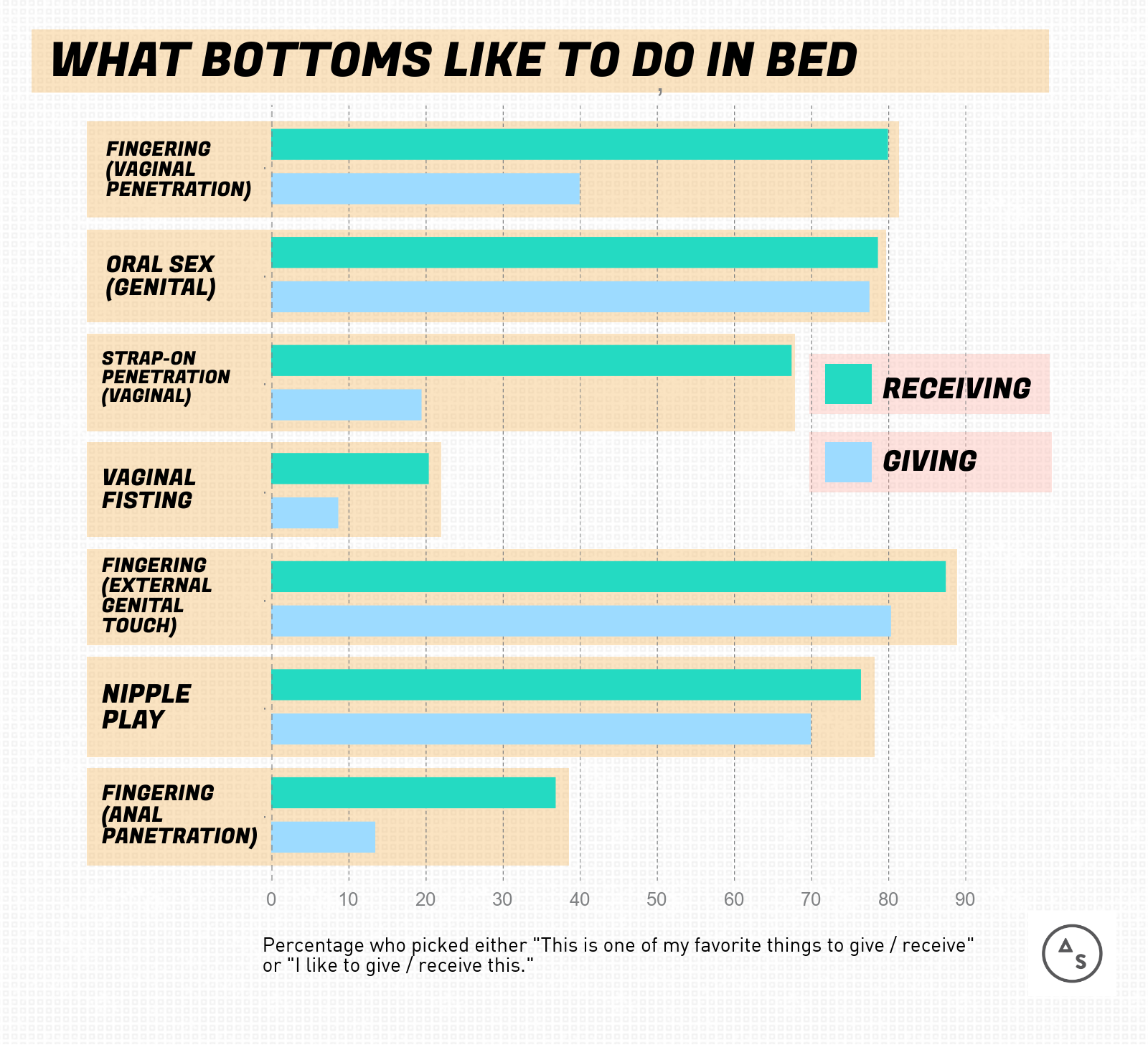
WHAT BOTTOMS LIKE TO DO IN BED: Fingering : 68.6% like giving, 81% like receiving // Oral Sex (Genital): 77.8% like giving, 78% like receiving // Strap-on Penetration (Vaginal): 20% like giving, 68% like receiving // Vaginal Fisting: 9% like giving, 21% like receiving // Fingering (External Genital Touch): 81% like giving, 87.6% like receiving // Nipple Play: 70% like giving, 76.5% like receiving // Anal Penetration: 12.5% like giving, 37% like receiving.
So, “Bottoming” Can Mean…
Getting Penetrated Exclusively or More Often
For gay men, tops penetrate and bottoms get penetrated. In lesbian sexual culture, the only word that absolutely means “I don’t get penetrated” is “stone,” but many bottoms defined their role like this one bottom did: “the one being fingered, the one being fucked by the strap on, etc.” 30% of bottoms said digital penetration was one of their favorite things to receive and 32% said the same for strap-on penetration, compared to 9.5% of tops and 5% of tops, respectively.
“I think being a bottom typically just means you like getting fucked,” Ari, a non-binary writer told me, “and tbh that usually just means you like being fucked first, since people (hopefully) tend to reciprocate.”
One blissful bottom on our survey described bottoming as “one who follows the lead of a more dominant partner during sex and/or the partner who is usually on the receiving end of sex acts, although since queer/lesbian sex is so varied, that can be more the feeling of being the one getting fucked than a specific role in a specific sex act.” Oral sex, for example, can truly go either way — going down on somebody can feel super toppy or super bottomy, depending on the context, the power dynamic, the dirty talk around it, and other physical actions and cues.
Letting Someone Else Take Control Of The Sexual Experience
On our survey, only 10% of bottoms said they liked “being in control” in bed, and a whopping 47.4% said they actively don’t like being in control. This came up a lot in respondents’ own definitions too, with one bottom defining their persuasion as: “Someone who is happiest letting other people take the lead in a bedroom situation.”
“Bottoming is an act,” says Ari, “which to me means choosing to let someone sort of determine the direction our sexy time will take.”
“To me, being a bottom means I like to cede control in bed,” wrote one bottom on our survey. “I am kind of a control freak normally, so letting someone else take control can be very liberating.”
“It’s not a literal physical stance/position for me,” said another brilliant bottom, “but related to a lack of comfort in initiating the situation, taking control, etc.”
We asked about initiation on the survey, too — 32% of bottoms (not an insignificant number!) like initiating sex, compared to 76% of tops and 65% of switches.
Preferring To Be Pursued
Oftentimes top/bottom identities play a role in how a person identifies potential partners and subsequently make suggestive connections with them, regardless of what happens when they actually get into bed, remove their clothing, and begin rolling around naked while sticking things inside each other. Of bottoms, 29% enjoy pursuing a new partner (and 28.5% don’t like it), but 64% — over twice as many — enjoy being pursued.
Receiving… Something
Allison Moon, in her excellent book Girl Sex 101, says “to bottom is to practice the great art of receiving… as a receiver, the giver is in service to you and your pleasure. It is your job to navigate. It’s her job to drive.”
“It took me a while to figure out I was mostly a bottom,” said Casey. “I think at first I thought top and bottom were only for gay guys? I only really realized because it dawned on me that for my partners it was an absolute must to be doing things to me for them to be excited and for me it was like, oh that’s fun but not strictly necessary for me to be turned on.”
While almost all our survey-takers don’t not like receiving pleasure, 93% of bottoms and 93% of switches actively like it, compared to 65% of tops. However, the vast majority of tops and bottoms were into pleasuring their partner — but that could mean so many things! As one switch put it, “I’m a giver, 90% of sex for me is enthusiastic giving until my partner is satisfied. That’s what feels good to me and turns me on, by the time they’re done i’m ready to pop and it takes about 10 seconds to finish.”
Kinky Bottoms and Submissives
Within a kink context, “bottom” can mean something different. According to BDSM-focused The New Bottoming Book, a “bottom” is “someone who has the ability to eroticize or otherwise enjoy some sensations or emotions — such as pain, helplessness, powerlessness and humiliation — that would be unpleasant in another context.” It does seem that most survey-takers who adopt “top” or “bottom” identities have some interest in kink, too — and bottoms were actually more likely to be kinky than tops or switches. 41% of bottoms identify as kinky and 44.6% said they don’t identify as kinky but sometimes enjoy kinky sex.
What Do Kinky Bottoms Like?
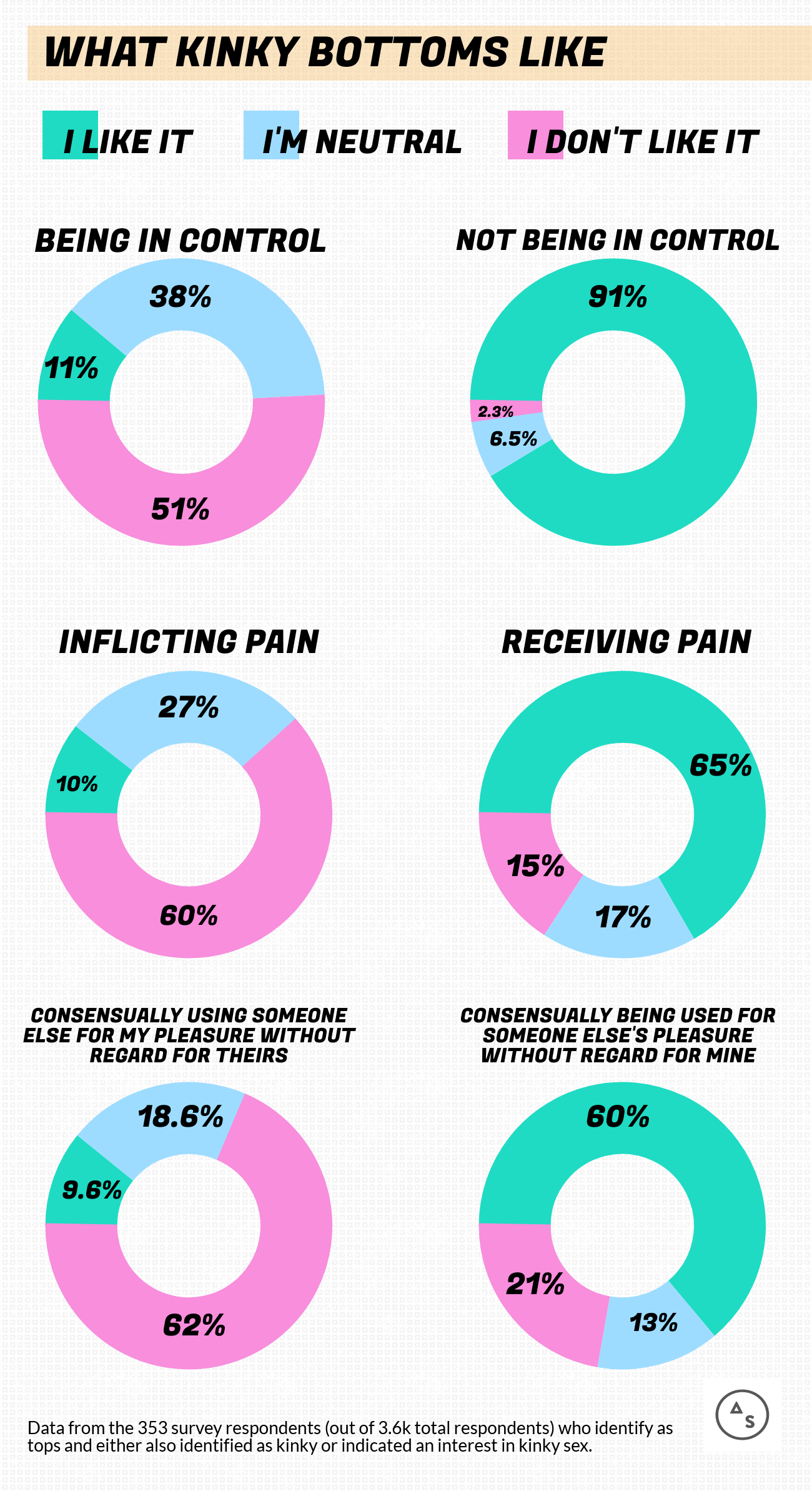
WHAT KINKY BOTTOMS LIKE // Being In Control: 11% like it, 51% don’t like it, 38% are neutral. // Not Being In Control: 91% like it, 2.5% don’t like it, 6.5% are neutral. // Receiving Pain: 65% like it, 15% don’t like it, 17% are neutral. // Inflicting Pain: 60% don’t like it, 10% don’t like it, 27% like it // Consensually being used for someone else’s pleasure without regard for mine: 60% like it, 13% are neutral, 21% don’t like it // Consensually using someone else for my pleasure without regard for theirs: 62% don’t like it, 9.6% like it, 18.6% are neutral
Three activities on our list of “elements of a sexual experience” were distinctly favored by self-declared kinky bottoms than non-kinksters, included on the chart below.
In comparison to the above data, 14% of non-kinky bottoms like receiving pain, 62% like not being in control, and 22% like being used for someone else’s pleasure with no regard for theirs.
But within the context of kink, what separates the concept of “bottom” from “submissive”? In consultation with Ryan, we decided to separate “bottoms” and “submissives” on our survey. Only kink-identified survey-takers were subjected to an additional survey page with questions about dominants/submissives and sub-identities therein, and now we’re gonna talk about those results.
![]()
How Many Submissives Are Out There?
Well, ladies and otherwise-identified people, while rumors of a Top Shortage may be overstated, the queer kink community may indeed be suffering from a Dom Shortage.
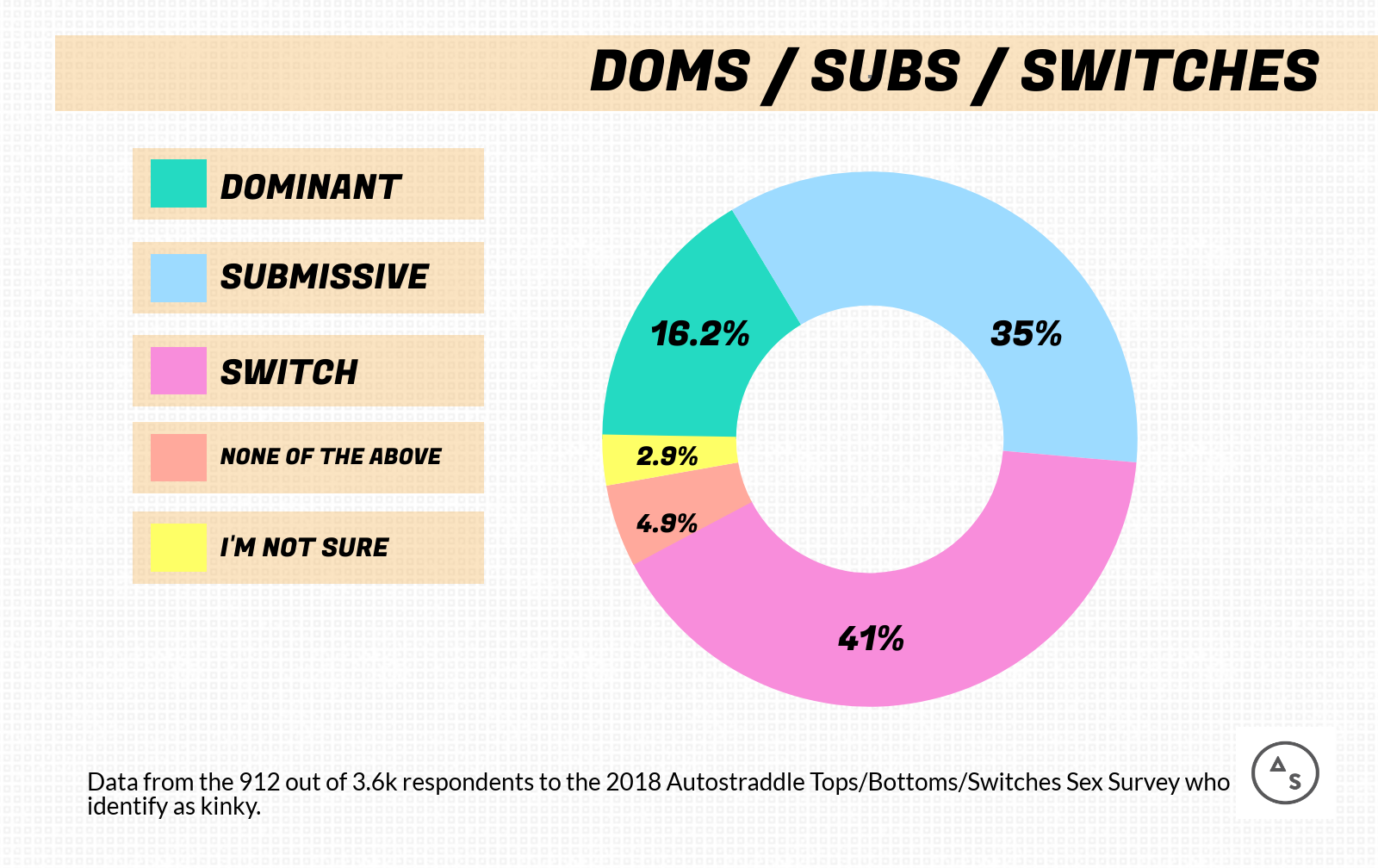
Numbers of Dominants / Submissives / Switches: 16.2% Dominant, 35% Submissive, 41% Switches, 4.9% none of the above, 2.9% I’m Not Sure
Of all kink-identified bottoms, 90% identified as submissives.
What’s The Meaning of “Submissive”? The Difference Between Bottoms And Submissives
“A bottom likes to be directed because it’s easier to please those who know what they want,” said the only bottom to identify as a switch in kink play. “A submissive gets off on the command and obey pattern and tension.”
N, a trans guy and a switch, explained the difference this way: “Bottoming definitely doesn’t automatically mean anything kinky (same for topping), while submissive (and dominant) mean something more specifically related to kink and power play.”
In a group chat on the topic, A pointed out: “Submission is a fucking GIFT: just because I’m bottoming for you doesn’t mean I’m your submissive.”
R, who identifies as submissive, added: “Also, just because someone is submissive doesn’t mean they’re bottoming!”
Many survey submissives didn’t consider there to be a difference between the two terms, but most did. All that’s clear is that these words, like so many things, are fluid as fuck.
“I identify as both a sub and a bottom, but subbing means something more specific for me — choosing to temporarily give power and control in a situation to another person(s) and letting them determine the course of events based on our negotiations,” Q, a non-binary person, told me. “It often comes with an implication of a particular high level of intensity in that power exchange. When I say I am a bottom, I am referring to this as well as more broadly being on the receiving end in less power-heavy sex.”
On our survey, there were as many different definitions of this distinction as there are bountiful bottoms in this pure earth, but aside from the eroticization of power play, the majority drew the line around kink (“a submissive is a kinky bottom”) or between a physical position versus a state of mind. Those who fell into the latter camp were also more likely to define bottom as being more logistical than psychological. Other interesting comments included:
- “A submissive can be dominated into GIVING. In my opinion a bottom can be dominant but receiving, giving but submissive, receiving and submissive, but NOT dominant and receiving.”
- “I would argue that bottom isn’t always a D/s term, while submissive is very very rooted in D/s. Bottom feels inherently queer, whereas submissive can be un-queer.”
- “Submissive refers to power play, whereas bottom refers to sensation play.”
- “A bottom /might/ give up power to their top. A submissive /will/ give up power to their dominant.”
- “Subbing isn’t about whether you’re the top or bottom, it’s about the power in the dynamic. you could be the person flogging somebody else, but if it’s happening bc somebody else told you to, that’s topping and subbing.”
- “Bottom doesn’t have the same power exchange connotation. Bottoms may get fucked but don’t necessarily enjoy pain or humiliation. Submissives get of on doing what their partner says, which can include fun subversive things like topping from the bottom (the inverse of service topping)”
The concept of “submissive“ as a lifestyle came up a lot, too. “The submissive yields/gifts control to the dominant,” wrote one sub, “and sometimes that’s for a scene, and sometimes that is 24/7 depending on the individuals.” (One of my favorite Bottoms Up posts is Ari’s piece on being submissive 24/7)
Ryan explained their relationship to the terms this way: “To me, being submissive informs my whole way of interacting with the world and succeeding at it and being my best most powerful self, and bottoming is part of that but not a huge part. ”
There are many more deviations within: power bottom, bossy bottom, little girl/baby girl, masochist, which we talk about here.
![]()
Finally: Don’t Assume Anything
Is it true that femmes were more likely than mascs to identify as bottoms? You bet! Does that mean all femmes are bottoms? Absolutely not! Making assumptions about somebody’s bedroom behavior based on gender presentation is never a safe bet.
Nor is it safe to assume bottoms prefer certain sex acts or dynamics. Bottoming can mean so many different things, all at once or independent of each other: proudly showing what you can “take,” being ravaged for somebody else’s pleasure, having all the focus entirely on you, being bossed around, or just a slight preference for having a dildo inside you instead of looped into a leather harness around your waist. However you bottom — if it’s consensual and you’re having fun, keep it up.
If you’re looking for more discourse on the meaning of these terms before or after reading about bottoms, we got you covered:
- What Does It Mean To Be a Switch in Lesbian Sex?
- What Does It Mean to Be a “Top” or a “Dominant” in Lesbian Sex?
- Service Tops, Bratty Bottoms and Pillow Princesses: Other Words You Use to Describe How You Have Sex
- Tops, Bottoms, Switches: One Last Look at All The Survey Data
A lot of the language in these posts is intended to make them easy to find on search engines. Some of the body parts we talk about will be yours or your partners’ and some won’t. Some of the pronouns will be yours or your partners’ and some won’t. Some of the sexualities will be yours or your partners’ and some won’t. Some of the language will be yours or your partners’ and some won’t. Take what you want and what applies to you or what you can make apply to you and your partners and your experiences, and leave the rest!
Service Tops, Bratty Bottoms and Pillow Princesses: Other Words You Use to Describe How You Have Sex
When you’re talking about terms like top or dominant, bottom or submissive and switch, a whole other world of terms can often rise to the surface: service top, pleasure top, bratty bottom, and so on. So, that’s what we’re talking about today: words that come up when we say those words, which I have called “sub-identities.” I realize that this is confusing because it sounds like “submissive identities” but you know, what can I do, I didn’t write the dictionary. If I had, “gay” would be defined as “a thing that everybody is.”

This isn’t a full glossary of terminology queer people use to talk about how they have sex — it’s just what y’all told us that you’re into on our “Tops and Bottoms” sex survey, specifically the question that asked 924 survey-takers who identified as kinky, “are there any other terms you use to describe how you like to have sex or the role you play in sex (e.g, service top, sadist, bratty bottom, stone, pain switch)?” In retrospect, we should’ve asked this of everybody, as not all of these terms are kink-specific! But alas, we live and learn.
Any stand-alone quotes included as definitions that are not otherwise cited came from your survey responses. Most of this stuff was totally new to me! Also don’t @ me about the daddy section, thank you.
![]()
I. Terms Relevant To Both Vanilla And Kinky Sex
What is a Service Top?

illustration by Archie Bongiovanni
A service top is a top who acts according to what pleases their bottom, which pleases them. “I like giving my partner exactly what she wants even though I’m the one technically calling the shots,” wrote a soft butch lesbian service top. “I’m not an aggressive top or dom,” wrote another lesbian service top, “but rather my topping comes from a place of care.” Another defined the meaning of service top as “a submissive service role in a position of giving sexual acts.”
If you’re wondering about service top vs service bottom and what a service bottom is — it’s more often used in a kink context, but it’s essentially a bottom who is bottoming for the benefit of their top moreso than for their own immediate pleasure. “Spanking doesn’t get me off,” wrote a service bottom, “but I’ve done it for my dom. That’s what service bottoming is to me.”
What is a Pillow Princess?

illustration by Archie Bongiovanni
Someone who receives pleasure during sex but does not actively provide it. Is often used in a derogatory way and should not be! “Pillow princesses are braver than the US marines,” wrote one proud Pillow Princess. One agender biesxual in a relationship with a stone woman wrote, “I’ve kind of adopted pillow princess as a role in my current relationship because I’ve stopped asking if my partner is sure they don’t want me to do anything and it’s a bit of a joke between the two of us.”
What Does “Stone” Mean, Sexually?
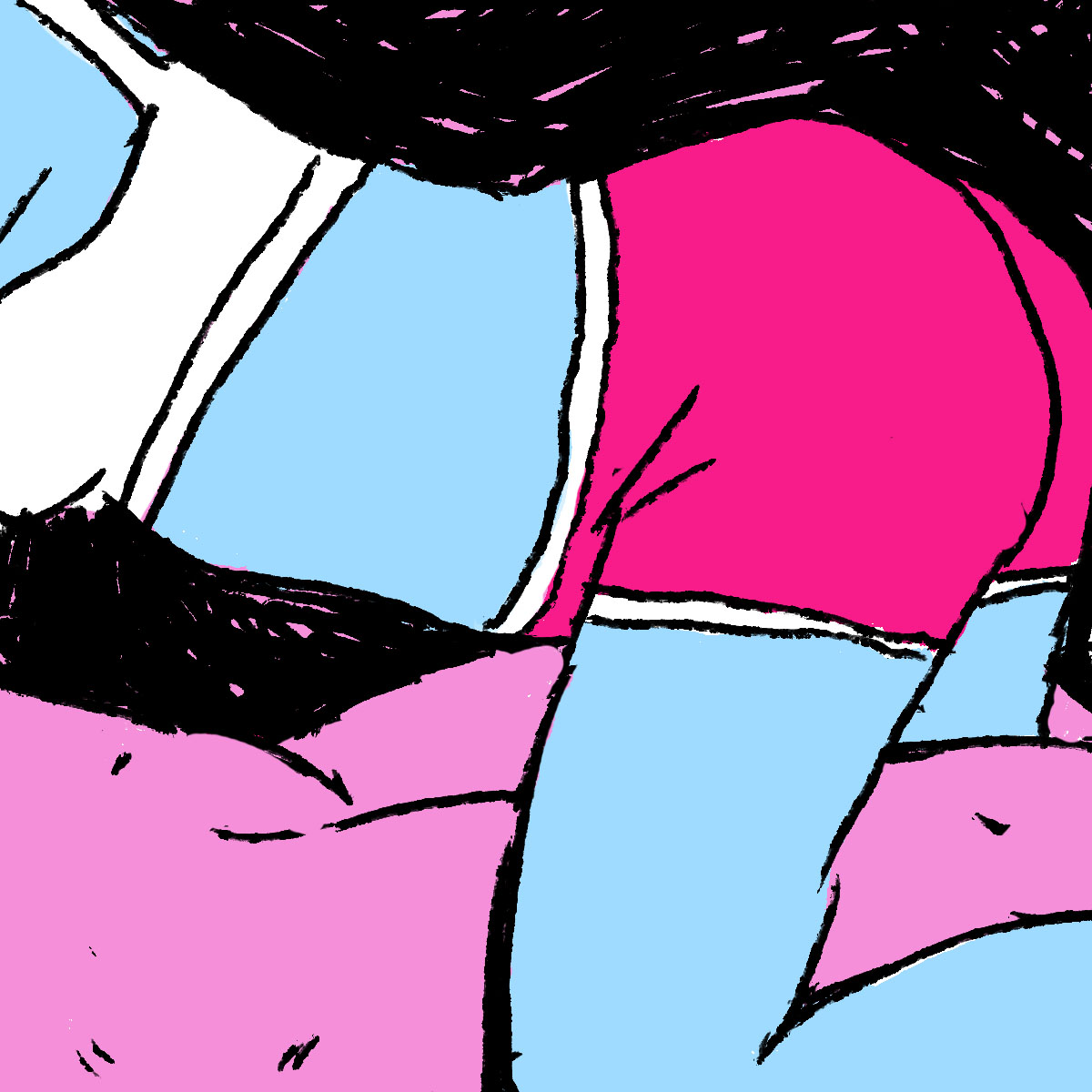
illustration by Archie Bongiovanni
Someone who does not want their genitals touched during sex. “I have no problem pleasing my partner, touching her intimately and making her orgasm,” wrote one soft butch lesbian. “While this does turn my nether regions into swampland, I have no desire for her to reciprocate the intimacy through genital or erogenous zone touching.”
One stone explained: “I don’t want my body to be touched except under my direction or if I have given explicit in the moment consent to a partner I trust and am comfortable with.”
Another described themselves as a “rollin’ stone,” which they defined as: “I’ll sit on your face and tell you what to do for me occasionally and I’ll make you beg to be allowed to … but you’d need to have been pretty damn amazing and gained my trust to stand a chance. Only one relationship ever got to that.”
Due in part to its popularization by the novel Stone Butch Blues, this is often identified as a response to sexual trauma, as it was for the novel’s narrator. However, this is not always the case! Stone identities exist for a number of reasons, like a stone who told us that “it feels too intense and takes me out of the moment.”
What is a Power Bottom?
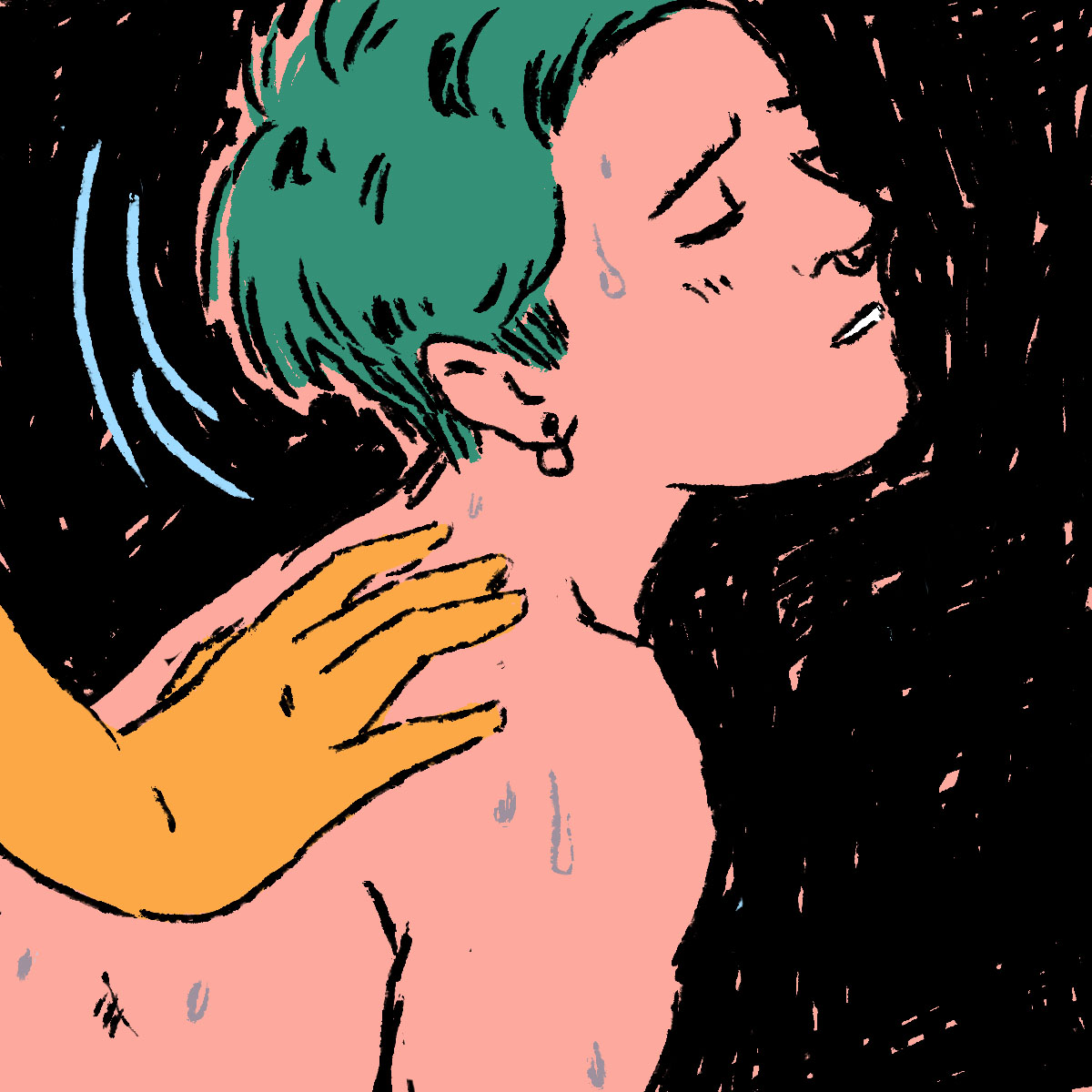
illustration by Archie Bongiovanni
“For me,” wrote one tomboy femme lesbian, “[power bottom means] being really participatory and active in everything that is happening, finding opportunities to tease my partner, enjoy keeping them on their toes in a playful way, and using my sexual power to connect with them from my point of view.”
A kinky power bottom described it like this: “To me it encompasses being dominant by guiding the scene but doing it from a bottoms perspective. (ie: telling my top what to do, where to strike me next, what activity I’d like to do, etc. while I receive the physical aspect of the scene).”
Another take: Power bottom “is way more about the intensity with which one is bottoming,” according to one non-binary queer.
Power Bottom vs. Bossy Bottom
I’ve heard the difference between “power bottom” and “bossy bottom” described like this: if the top is in the driver’s seat, the power bottom is the one in the passenger seat who has the directions pulled up, knows the area, and has her eye out for cops, whereas the bossy bottom is a backseat driver who kinda knows the way but mostly just has input. That description is, obviously, a little negative regarding the bossy bottom. Indeed, in gay male culture, it’s bad to be a bossy bottom. But y’all described “bossy bottom” as more of a good thing! One queer woman referred to “bossy bottom” as “a dominant role in the receiving position of play,” which sounds like a great way to be.
What is a Bratty Bottom?

illustration by Archie Bongiovanni
This was a very popular mention — and it’s an identity we’ve written about before. “I love playing with power dynamics but I can’t take it seriously because it’s all contrived,” wrote one brat. “I don’t want to beg you to orgasm or hand over power just because you call yourself a ‘Dom’ just to pander to your ego; if you want to play with power and control, you’d better be prepared to make me do what you say.”
“I think [being a brat/bratty bottom] allows me the ultimate ‘release’ of submission but lets me engage and tease,” wrote a lesbian femme. “I feel like I get to show a greater range of my actual personality and intelligence, and it feels more authentic to who I actually am, in terms of my sarcasm, dark humor, etc.”
“I’ve heard bratty subbing be compared to or called ‘topping from the bottom,'” wrote a queer femme, “and I don’t really identify with that — I still definitely want my partner to have control and power and make the decisions.”
What is a Brat, Sexually, and What is a Brat Tamer?
Bratty bottom but without the bottom part! “I’m a brat, whether I’m topping or bottoming,” said one of these people. A brat tamer is one who deals with the bratty bottoms or “the dom who has to deal with the brat and usually punishes them for their disobedience.”
![]()
III. Kink-Specific Terms
What is a Sadist, Sexually?
“One who derives pleasure from inflicting pain, intense sensations, and discomfort on someone else.” – The Ultimate Guide to Kink
Forty-three respondents identified as sadists, and about half of that group also identified as masochists, with another eight identifying as sadomasochists. Sadists, as per the dictionary, get pleasure out of causing another person to suffer regardless of whether or not that person is enjoying themselves or wants to experience that kind of pain. But, in sexual practice, a key element of sadism is consent — the one receiving pain has consented and communicated what they’re into. Pain inflicted by the sadist can be physical (e.g., spanking, biting) or emotional and psychological (e.g., humiliation, orgasm denial).
“I feel a sense of sick joy and glee when someone is crying, screaming, or otherwise physically hurting,” wrote one sadist. “Some of it has to do with me enjoying being in power over someone, but that is only part.” But sadism is a delicate art, and can feel conflicting, too: “I will admit I have a difficult time accepting the sadistic side of myself, even if the pain I cause is consensual. I’m a caring, empathetic person, and I’ve always been taught that good people don’t hurt others, and they certainly don’t enjoy hurting others.”
A ‘soft sadist’ might enjoy giving some pain but not too much. ” “I like to inflict a little bit of pain on my partner,” wrote one, “and also enjoy denying her orgasms, which is kinda torturous for her.”
“I’m definitely more of a ‘sweet sadist’ or ‘sensual sadist’ where there’s a lot of reassurance and embarrassing/cutesy sayings thrown in,” wrote a lesbian domme. “Sometimes I’ll laugh at them in a gentle way. It’s not from a place of cruelty, ever.”
What is a Masochist, Sexually?
“Someone who enjoys receiving pain or intense sensations, being made uncomfortable, or being ‘forced’ to do something they don’t enjoy.” – The Ultimate Guide to Kink
Most masochists described their affiliation as “getting pleasure from pain.” “I fucking love being hurt (leather belts are my favorite),” wrote one lesbian genderqueer woman. “I like being bitten and spanked and I get aroused because of that,” wrote a bisexual woman.
“Receiving pain isn’t as much about D/s for me as it is about sharpening sensation so I can get out of my head and be present in the moment,” wrote one gay woman. “It feels like turning off my brain, and grounding myself, via my body.”
What is a Sadomasochist
Although some respondents said they identified as both sadists and masochists, some used “sadomasochist” specifically, which refers to those who enjoy giving and receiving pain. Sadomasochism, wrote one femme top, “describes the amazing pleasure I get from delivering consensual pain as well as the pleasure I get from controlling the way certain types of pain are delivered to me (like how I LOVE to have my bratty bottom partner bite me really hard when they’re inside me and I’m spanking them at the same time).”
What is a Pain Switch?
Turned on by pain — giving it or receiving it. Similar to sadomasochist, perhaps more comfortable for those who don’t necessarily feel affinity to those terms for any assortment of reasons, like maybe not being into the psychological element or preferring the pain recipient to be visibly enjoying themselves (as in; no consensual non-consent). To each their very own!
What Do the Terms Daddy/Mommy Mean, Sexually?
These terms, considered part of age play, came up in 35 answers, either mentioned as somebody’s identity or the identity of their partner. Generally in heterosexual kink, a man taking on this role would identify as a Daddy and a woman would identify as a Mommy, but we’re queer, so actually Daddy was mentioned twice as often as Mommy on our survey.
Of course, “Daddy” can sometimes just be a word you say during sex that has certain power dynamics or some element of age play, but for others, it’s a more concrete identity. It is a form of domming that incorporates “parental” behaviors: protecting, leading, exerting authority, being nurturing or caretaking, and also delivering scolding and punishments for misbeheavior.
“I’ve recently become a Daddy to my boy (who is a butch cis woman),” wrote a queer femme. “As a chronicly ill/disabled person, domming my lover in this way has given me so much more than just pleasure for both of us. It’s given me a new sense of confidence, and of having some control in my life for the first time since I became ill. While I’ve always leaned more towards being a sub in the past, I feel like I’ve really flourished by becoming more dominant. There is something so nourishing about being in charge again after three years of being so physically (and financially etc.) impotent. And when I’m Daddy, it’s all about taking care of someone else, instead of being taken care of, which is very empowering right now. I love that my boy is so turned on by me, feels taken care of and is desperate to please me.”
“It means that while I want my partner to submit to me and while I want to be in control of the situation,” wrote another self-identified Daddy. “I also want my partner to feel taken care of and fulfilled.”
One “little girl” defined “mommy domme” as “where instead of a domme in the masochistic way, the domme takes on a more caring, nurturing role. Gentle femme domme, if you will.” Another said, “I just like the mommy dynamic bc submission takes on a warmer and patronizing flavour, if anything it’s the feeling of being taken care of and condescended to that makes being a little so hot.”
“I like Mom or mommy,” said a trans lesbian. “Largely this is just the somewhat cathartic thing where folks get to be beaten up by a nice lady. I’m anti-daddy, and not a huge fan of mommi, but I’m all the way here for a fist full of mommy.”
Finally, this: “I’m a femme, and I have a femme daddy and that’s pretty hot.”
What About Little Girl/Boi / Babygirl / Good Girl/Boi / Bad Girl/Boi?
Usually described as part of a Daddy/little dynamic. “I identify as a babygirl,” wrote a femme lesbian. “I enjoy feeling cared for and cherished by my girlfriend, who identifies as a daddy. She provides a feeling of safety and security for me when in this role that I have never had with previous partners, and enjoys the feeling of nurturing me when we play.”
Another wrote, “I have a Daddy and engage in age-play and D/s. This means I’m a slutty little princess who submits to my Dom and receives a lot of fucking and pain and care. I also carry out tasks and activities outside of sex to please my Daddy.”
“I’m exploring ‘little girl’ since I’m nonbinary and haven’t thought of myself as a girl/woman in years,” said a queer person. “But in bed, I really enjoy being called ‘good girl’ and ‘pretty girl.’ ¯\_(ツ)_/¯ Who the fuck knows what gender is anyway?! I just wanna have some awesome orgasms without thinking about that ugh.”
“Good girl,” “bad girl” and “bad boi” were also brought up as words used frequently in scenes involving Mommy/Daddy and little dynamics.
Finally, another little/babygirl added to her description: “In little-space I don’t have to worry about student loans.”
Temptress
“I like creating an environment in which someone can choose their response and the illicit thrill with knowing that they did this to themselves.”
Goddess
“Being in charge of the scene and topping the other person but through light and love. Deities disappear without followers so for me this is a place where I honor my partner worshipping me by sharing my power with them and lifting them up. ”
Pet / Owner
“When we take away out human masks to become more animalistic,” writes Lee Harrington in The Ultimate Guide to Kink. “Sometimes core parts of our identity come to the forefront in ways that we were unintentionally hiding from the world at large.”
Some survey-takers wrote of their interest in pony and puppy play or identifying as kittens. One described their identity as a “service otter.” Some described providing service to their owners, others of engaging in “primal play” (“playing more animalistic / rough and tumble”), others in more of a lifestyle situation. Like many elements of BDSM, there’s not always necessarily a sexual element — the focus can be more on cuddling or service. For example, this comic about puppy play explains that a “mosh,” or “puppy play meetup,” can be “a safe space… to receive cuddles and sensual touch without the expectation of sex.”
Prey
“I like feeling like I’m being hunted down.”
Predator
Hunts down the prey. Part of primal play, which can include playing with fear in dominance/submission and “animalistic” raw/unfiltered play.
[Pain or Humiliation or Etc] Slut
“Slut” hooks up with other words to reflect, basically, a bottomless appetite for something. Pain sluts want pain and torture, humiliation sluts want humiliation, sensation sluts are into a variety of physical sensations — floggers, canes, whips, hands, chains, rope, electric shocks, etc. “Impact slut” was another term mentioned, but not described by the person who mentioned it or within any kink reference materials I have access to. I’m gonna go out on a limb here and say it’s being super into impact — getting hit, spanked, punched, kicked, etc.
Hedonist
“I enjoy pleasure overall more important that playing a specific role,” wrote a queer trans woman. Another hedonist opined, “let’s all just have beautiful orgasms, hopefully together.”
Pleasure Dom
“Dominating in order to do what you know will make the other person come hard, which is the turn on for myself.”
Service Sub
Like service top sometimes, service sub is not necessarily sex-related and can part of a 24/7 D/s relationship, where one’s submission is oriented towards doing helpful things for someone else. “I get pleasure from serving my dom in almost whatever way she wants me to,” wrote a queer woman. “This includes things like foot massages, cooking and cleaning for her, repairing her clothing, opening doors for her and generally following orders.”
Service Switch
“I enjoy being of service as much as I enjoy being served.”
![]()
These are just some of the many ways people identify, and probably just some of the many definitions for the terms included here. Don’t forget to feed your service otter!
Tops, Bottoms, Switches: One Last Look at All The Survey Data
Hello and welcome to our final journey into the annals of data collected by me, from you, regarding your feelings about the sexual terms top / bottom / switch. We’ve already discussed:
- What you mean when you say “bottom” or “sub”
- What you mean when you say “top” or “dom” (which also included a brief gender conversation)
- What you mean when you say “switch”
- Sub-identities like “pillow princess,” “service top,” “bratty bottom,” etc.
- 55 Very Deep Thoughts About Your Sex Life You Shared With Us On Our Recent Sex Survey
- A+ Roundtable: Our Bottoms, Our Tops, Our Switches, Ourselves
Now we’re going to look at the survey responses as a whole, and how various other identities, practices, lifestyle situations and relationships intersect with the identities I decided to really really demolish over the past few months.
![]()
Just a Reminder
One last time with feeling, this is how the numbers shook out:

Tops: 12% // Bottom: 14.3% // Switch: 51.6% // None of the Above; 13.4% // I’m Not Sure: 8.9%
![]()
Looking at All The Data
Sex Acts
We’ve broken down popularity of various sex acts by sexual identity in previous posts. Here’s what the entire group is into:
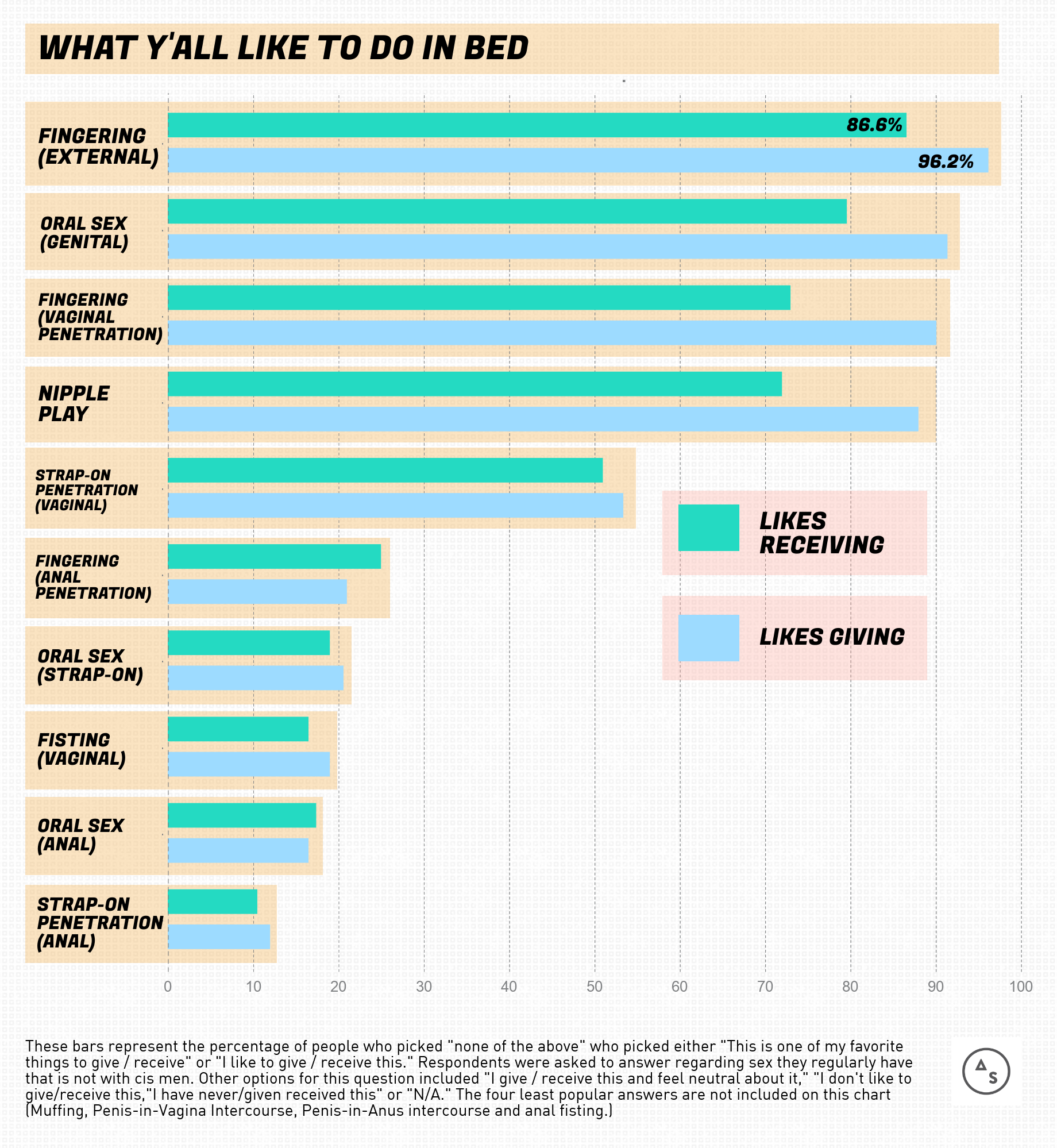
Notably, despite there being slightly more bottoms than tops in our group, y’all prefer to give things more than receive them pretty much across the board — unless it involves putting your mouth or finger in somebody’s asshole, at which point you’d rather have somebody do it to you than do it to somebody! Interesting.
Sexual Frequency
Survey-takers were asked “Within the past six months, how often have you, on average, had sex?” This is how that turned out:
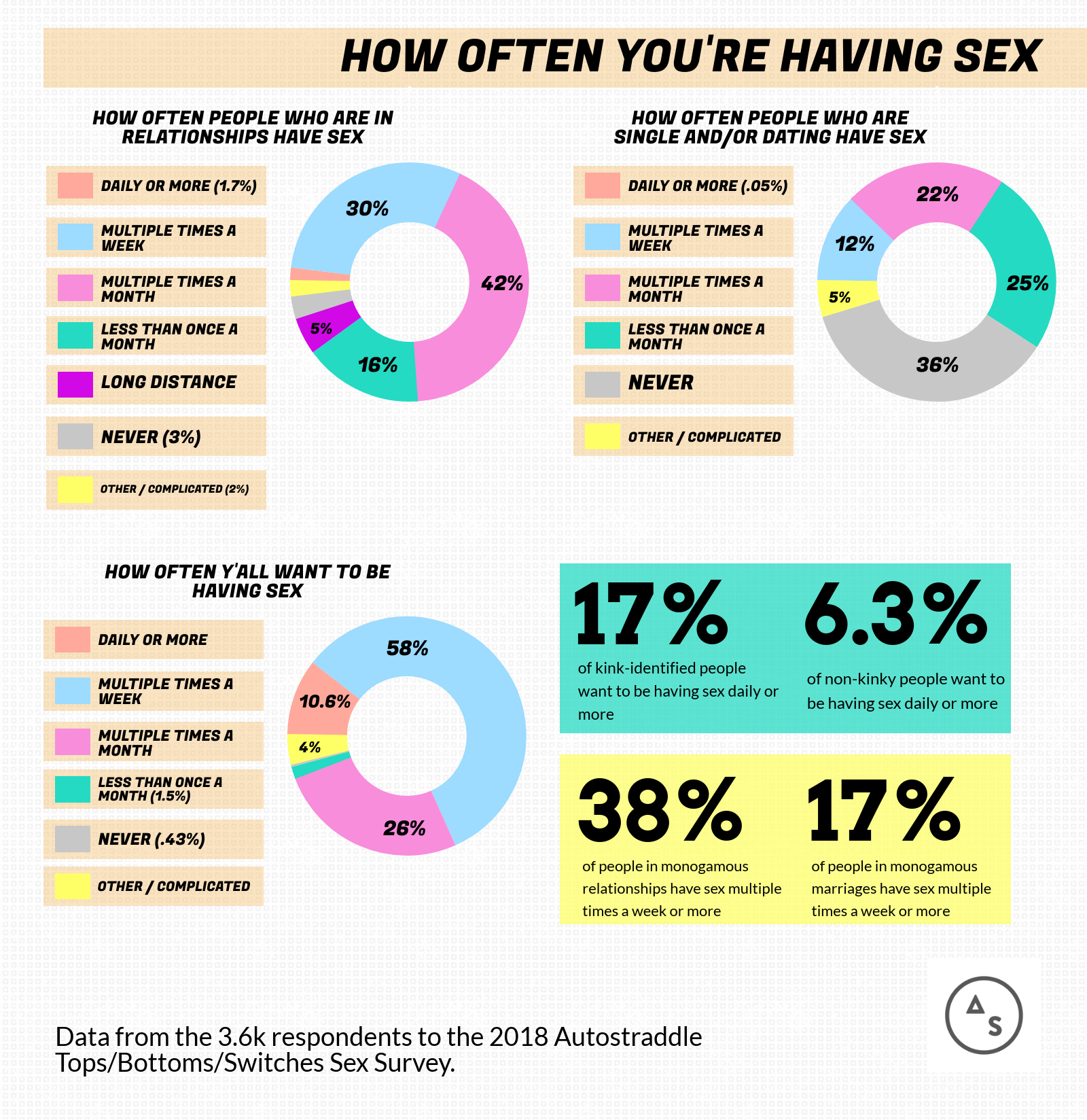
For the “Other/Complicated” option, survey-takers were required to describe their situation. I went through those and pulled all the ones that were about long-distance relationships and made that into its own category, and also pulled answers that did include a definite measure of sexual frequency and added those to their respective categories. Prior to doing so, around 10% of respondents picked Other/Complicated, usually because they felt simply picking one of the offered answers didn’t tell the whole story. Aside from long distance folks describing periods of daily sex alternating by periods of no sex, the most common situations mentioned here were people in uncharacteristic dry spells due to surgery, illness, depression or taking anti-depressants.
There wasn’t any significant correlation between top/bottom/switch identification and how often you have sex. In fact, aside from being in a relationship or not, not a whole lot impacted how often you reported having sex in a statistically significant way. Although most research shows opposite-sex couples have sex more often than same-sex female couples, the queers on our survey who were dating men were having sex at nearly identical rates as those dating women.
Also keeping even pace with each other? Those in monogamous and non-monogamous relationships, in line with the results of our 2015 Lesbian Sex Survey. We can’t really compare the two surveys because they were two separate self-selected samples, but it was interesting that the 2018 group seemed to be wanting and having way less sex overall than the 2015 group. Probably because of existential dread!
![]()
Sexual Experience and Positioning
Tops tended to have had more lifetime sexual partners than the other groups. 19% of tops have ridden the hobby horse with over ten women and 8% with over 20, compared to 9% and 3% for bottoms and 16% and 5% for switches.
Tops were also the least likely to have had sex with a man — 43% haven’t, compared to 37% of bottoms and 33% of switches.
![]()
Sexual Orientation
Here’s the basic breakdown of the group by sexual orientation:

Some noted correlations:
- 65% of Pansexuals identify as switches, compared to 51% of the entire group and 50% of lesbians and bisexuals.
- 51.5% of tops identify as lesbians, compared to 44% of bottoms and 42% of switches.
- 19% of bisexuals identify as bottoms, compared to 14% of the entire group.
- 15% of lesbians and 18% of gay people identified as tops, compared to 8.6% of bisexuals, 7% of pansexuals, 11% of queers and 12% of the entire group.
![]()
Gender Identity and Presentation
Here’s how y’all feel about your gender today:
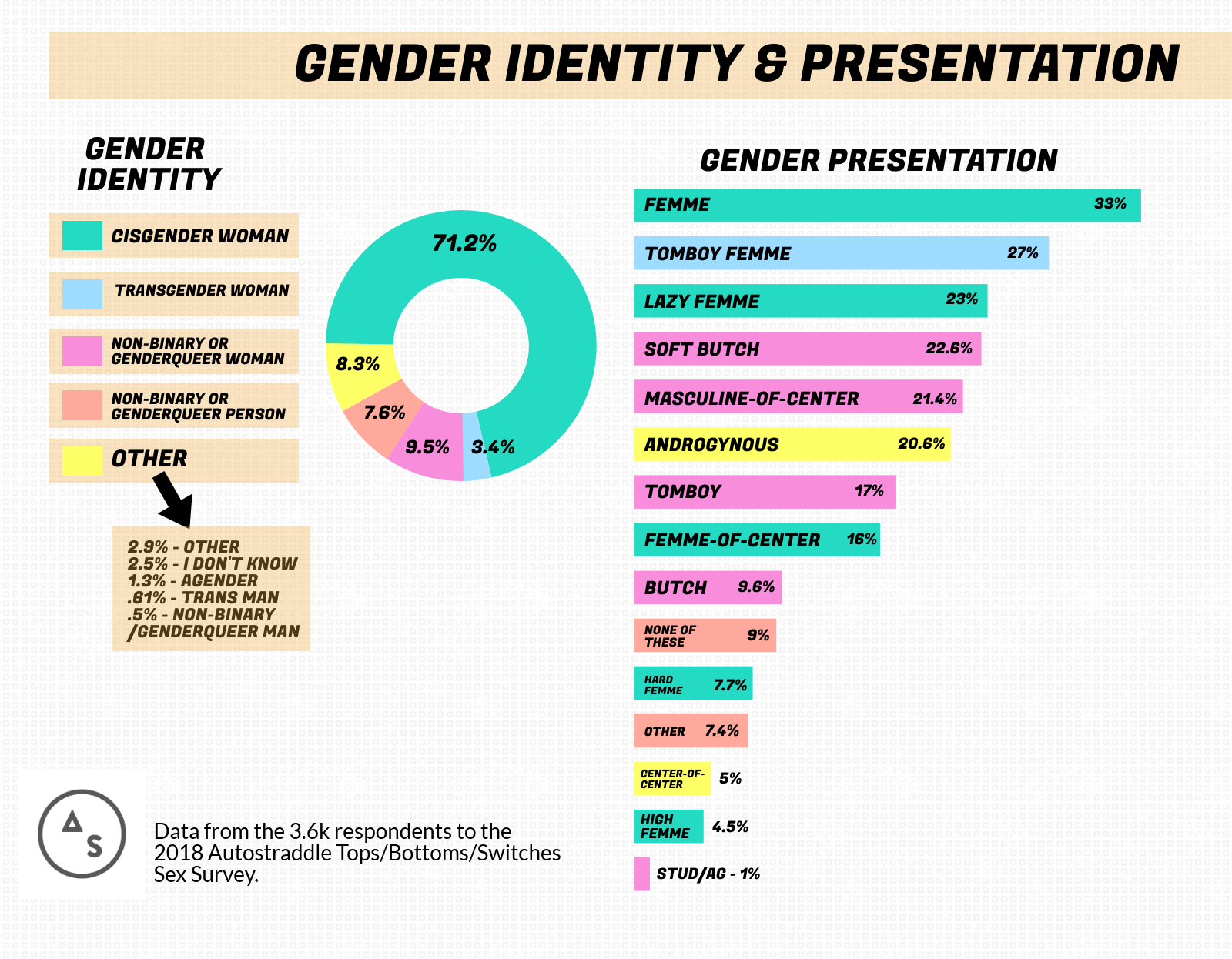
As discussed in our post on tops, our survey revealed that the “masculine partner = top” and “feminine partner = bottom” stereotype (which was, back in the day, an absolute directive) has a lot of truth to it, but it definitely can’t be applied across the board.

Around 8% of those who identified as high femme or hard femme identified as tops, compared to 12% of the entire group. Around 8% of soft butches and masculine-of-center folks identified as bottoms, compared to 14% of all survey-takers.
“Switch” was, of course, the most popular identity for all groups, with between 50 and 60 percent aligning themselves with switchiness — the only gender presentation with less than 50 percent being switch-aligned was butches, who just missed the mark at 49%. Tomboy femmes almost tipped the scale in the other direction but not quite — 59% are prone to switching it up. But, as discussed on the tops post, it’s never safe to assume what somebody’s into based on their gender presentation.
Many butches and femmes quoted in the tops post expressed frustration that they were assumed to be a top or bottom due to their gender presentation.
We also found some variances within gender identity and trans status too — like that trans women were the most likely to identify as bottoms. Non-binary/genderqueer men were most likely to identify as tops, but our sample size for that group (16) was too small to draw any significant conclusions.
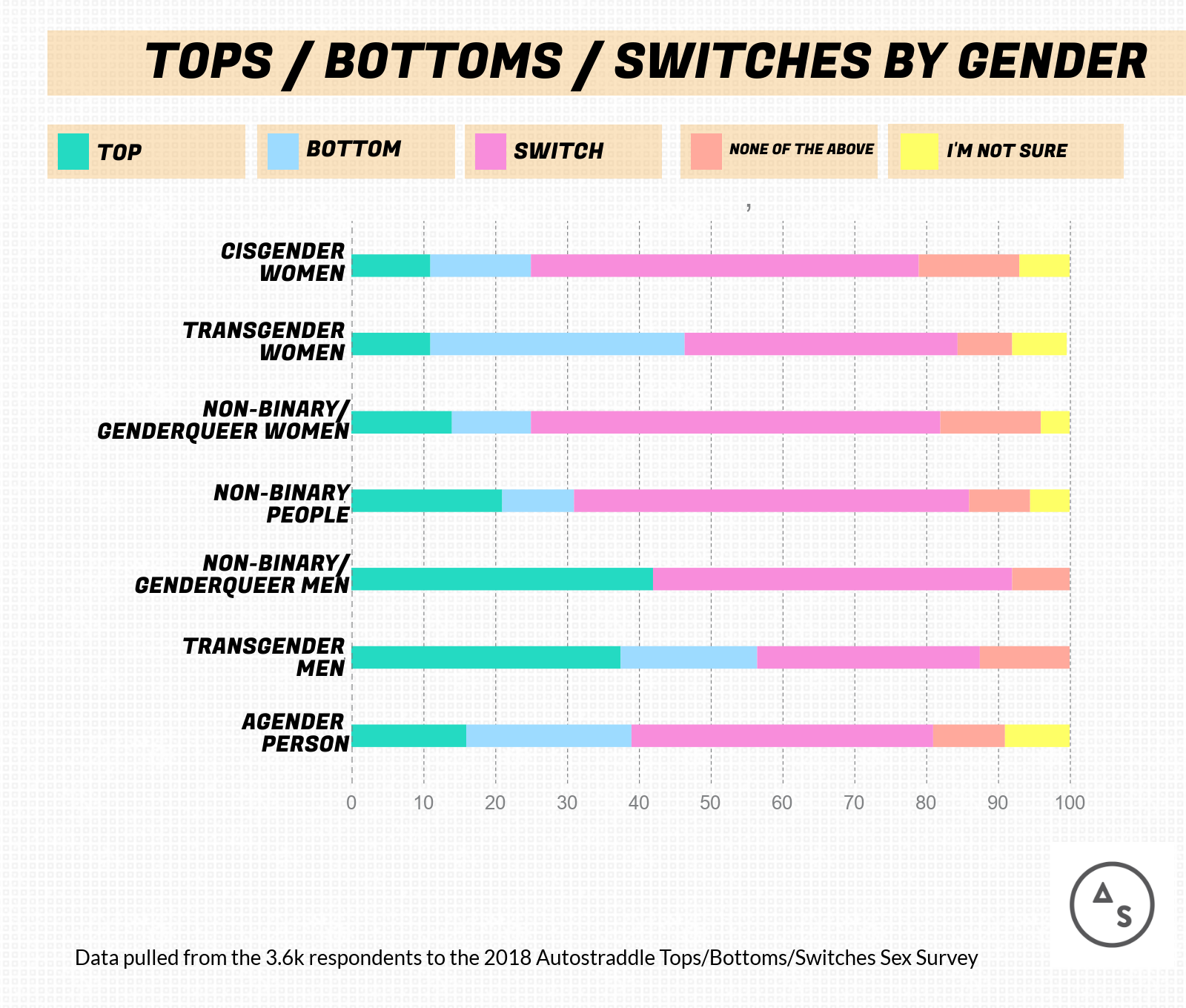
It also appears that non-binary/genderqueer women were most likely to identify as switches, and agender folks were most likely to “not be so sure.” Perhaps there is an overall correlation between being switches and identifying with terminology that some might consider oxymoronic, like “tomboy femme” and “non-binary woman.”
![]()
Geography – International
69% of survey respondents came from the U.S. and 31% were outside the U.S.. There were slightly more Europeans identifying as “none of the above” (17.6%, compared to 13% of people in the U.S. and 11% of Canadians). “I live in Europe, function in French (and Dutch), and for some reason “top”, “bottom” and “switch” here are mostly applied to sexual encounters between two male-identified people,” wrote one European, although to be fair, many Americans had the same impression.
“I don’t feel the need to apply categories,” wrote another. “I think its stressful and excludes possibility to experience without making a whole big deal out of it and panders to stockbuilding (as happens with categories of identity). But I am aware that it seems to be quite a thing in the US.”
We only had 109 survey-takers in Australia, but if that group is representative then I would like to offer a tip of the hat to the land down under and all my friends and family who reside there, you have evaded the alleged top shortage plaguing this nation with a remarkable 16.5% tops / 5.5% bottoms ratio.
Asia and Canada had similar numbers of people identifying with these terms as the U.S., and we didn’t have enough respondents in South America, Africa or Mexico to draw significant conclusions.
![]()
Geography – U.S.
83% of survey respondents lived in a city or major metro area and 17.25% in rural areas. We gave U.S. residents the option of indicating if they lived in nine specific cities/metro areas, or else they could say “I do not live in any of these cities or metro areas, but I do live in a city/major metro area” or “I do not live in a city or metro area.”
Lots of commenters chimed in to point out the nine cities we included were NOT the largest cities in this country or the most LGBT-populated cities. This is absolutely correct. In the interest of full disclosure: we have a writer doing a piece about one of those nine cities and therefore wanted to gather data about that city specifically, but it seemed weird to only ask about one city, so we threw in eight others more or less off the tops of our heads: New York, San Francisco/Bay Area, Los Angeles, Chicago, Atlanta, Boston, Minneapolis/St.Paul, Portland and Seattle.
Only 21 respondents were from Atlanta, a sample size too small for analysis. So we’re looking at those eight cities as well as other unlabeled city-dwellers (which I added Atlanta people to) and non-city folks. So you can arrange your grains of salt accordingly, here are the number of responses I had from each city: Portland, OR – 63, Los Angeles – 96, New York – 212, Chicago – 85, Seattle – 91, San Francisco/Bay Area – 124, Minneapolis/St.Paul – 53, Boston – 101.
This data turned out to be pretty fascinating and now I wish we’d asked about more cities! For the purposes of this analysis, I cut out the “I’m not sure” category, because SurveyMonkey said we didn’t have enough people picking that option for statistically significant results.
In order to compare city-specific data to the overall data, then, the overall numbers for the entire group with the “I’m Not Sure”s removed are: Top (14%), Bottom (15%), Switch (56.6%), None of the Above (14.5%)
- Highest percentage of tops: Los Angeles (22%), New York (17.4%), non-city/metro-areas (16.2%).
- Lowest percentage of tops: San Francisco/Bay Area (7%), Boston (9.7%), Portland (10.2%)
Regarding the tops in the non-city/metro areas, a “top shortage” theory we wrote down in my notebook was “ALL THE TOPS ARE IN THE WOODS / ON THE FARM?” But you know where else the tops are? On the 405 or trying to get a seat on the L train at the Bedford stop during rush hour.
- Highest percentage of bottoms: Minneapolis/St.Paul (24%), Boston (19%), Los Angeles (17.4%)
- Lowest percentage of bottoms: San Francisco/Bay Area (12.4%), New York (13.3%), Portland (13.6%)
It appears the bottoms are also on the 405 and quite a few are being helpful service-oriented neighbors to their fellow Midwesterners.
- Highest percentage of switches: Portland (66%), San Francisco/Bay Area (60%), Seattle (55.6%)
Portland is DTF, y’all, and happy to switch it up in order to meet your needs!
- Highest percentage of “None of the Above”: San Francisco/Bay Area (19.3%), Minneapolis/St.Paul (19.15%), Chicago (17%)
The people of San Francisco wanna blaze their own damn trails.
What about kink?
- Cities with the most kink-identified people: San Francisco/Bay Area (29.5%), Minneapolis (25.5%), Los Angeles (25.5%)
- Cities with the most people who are either kinky or down for kinky sex: Seattle (87%), Minneapolis (83%), Portland (80%)
![]()
If there’s anything specific you were curious about with regards to the data I collected or the open-answer questions we asked, let me know in the comments and if possible, I can address them in a future post!
What Does It Mean To Be a Switch in Lesbian Sex?
Hello and welcome to part three of our series on what the hell we mean when we say “top,” “bottom” or “switch!” Two weeks ago we talked about bottoms and submissives, last week we talked about tops and dominants, and this week we’re getting switchy, and also talking about people who don’t use these terms at all. Let’s get into it.
![]()
The Tops, Bottoms and Switches Sex Survey
Three weeks ago, I sent out a survey about these terms, and over 3.6k people showed up to share their tops and bottoms with me. These are the respondents’ demographics:
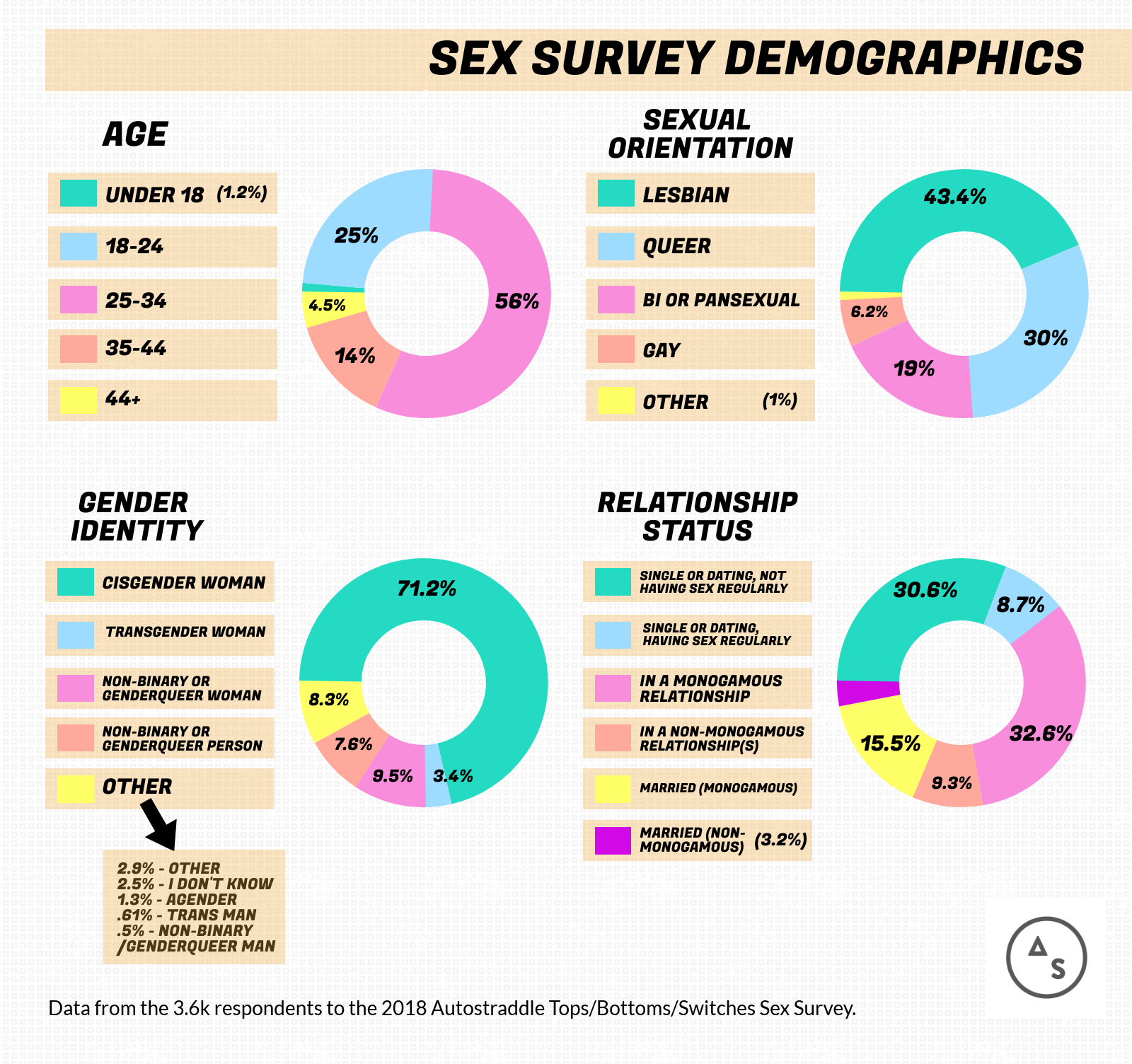
Demographics of Sex Survey Respondents // Age: Under 18 (1.2%), 18-24 (25%), 25-34 (56%), 35-44 (14%), 44+ (4.5%) // Sexual Orientation: Lesbian (43.4%), Queer (30%), Bi or Pansexual (19%), Gay (6.2%), Other (1%) // Gender Identity: Cis woman (71.2%), Trans woman (3.4%), Non-Binary or Genderqueer Woman (9.5%), Non-Binary or Genderqueer Person (7.6%), Other (8.2%) // Relationship Status: Single or Dating, Not Having Sex Regularly (30.6%), Single or Dating, Having Sex Regularly (8.7%), In a Monogamous Relationship (32.6%), In a Non-Monogamous Relationship (9.3%), Married & Monogamous (15.5%), Married & Non-Monogamous (3.2%)
I’ve been going through the data gradually over the course of the month — next week we’ll talk about sub-identities and the week after that we’ll talk about not-previously-discussed interesting trends in the data as a whole. Each week’s data builds on last week’s, we’ve all had a great nerdy sexy time with this and will continue to do so.
How Many Switches Are Out There?
Despite all the talk of tops and bottoms within the queer community, our survey revealed that people who identify specifically as tops or bottoms are in the minority overall. We switches, however, are ABUNDANT.

Tops: 12% // Bottoms: 14.3% // Switches: 51.6% // None of the Above: 13.4% // I’m Not Sure: 8.9%
What Is Switching?
Before queer women’s culture adopted top/bottom as terminology relevant to non-kinky sex, the terms were primarily used by gay men, or in kink or BDSM contexts by both straight and LGBTQ+ people. However, the term “versatile” or “vers” tends to be employed in those contexts as often as “switch.” (Most see “versatile” and “switch” as interchangeable, others don’t.)
There was obviously more consensus here than for tops and bottoms as defining “switch” rests heavily on pre-declared definitions of “top” and “bottom.” Switches were described as being interested in: topping and bottoming, giving and receiving, fucking and getting fucked, being the aggressor and the submissive, having control and not having it, giving and receiving pleasure, leading and following. Of course, there are plenty of sexual acts that aren’t easily defined by topping/bottoming, although top/bottom dynamics can absolutely be present in side-by-side grinding or even mutual masturbation — maybe this is less so when switches are involved, maybe not! Who can say!
![]()
What Do Switches Like to Do in Bed?
Despite a stated equal interest in giving and receiving most sexual acts, there were a few acts for which the percentage of switches who were down for giving exceeded the number who were up for receiving. The biggest disparities of that nature were for vaginal fingering (13%), genital oral sex (11%), nipple play (12.5%) and anal (8.7%).
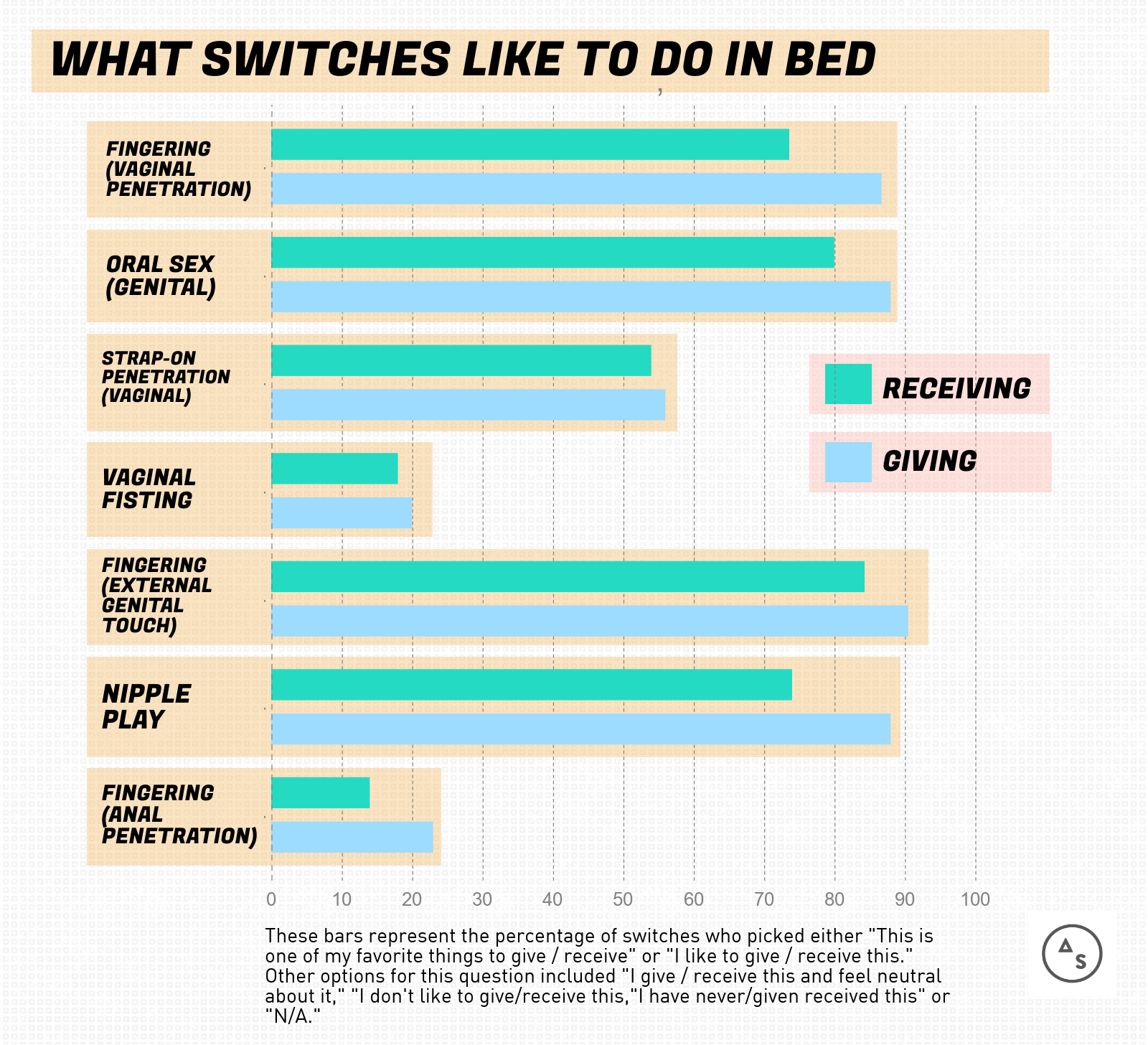
WHAT SWITCHES LIKE TO DO IN BED: Fingering (vaginal penetration) 90.5% like giving, 84% like receiving // Oral sex (genital): 88.3% like giving, 79.9% like receiving // Strap-on penetration (vaginal): 56.32% like giving, 54.05% like receiving // Vaginal Fisting: 19.9% like giving, 18% like receiving // Fingering (external genital touch): 90.53% like giving, 84.27% like receiving // Nipple Play: 86.4% like giving, 74% like receiving // Fingering (anal penetration): 22.78% like giving, 14.05% like receiving.
I noticed that in many areas, the percentage of switches interested in a certain sexual act or dating behavior was usually just slightly below the interest of tops (for top-associated) things, or of bottoms (for bottom-associated things). Here’s an infographic about that:

Switches: we sure are switchy!
![]()
So, Being a “Switch” Can Mean…
Doing a Little Bit of Both
“[A switch is someone] who spends time in both roles,” wrote one kinky lesbian femme, “but not just ‘she fucks me then I fuck her quickly afterwards’ but someone who enjoys equally spending time in each role.”
Preferring One, But Being Down For Both
Others indicated that an interest in both positions did not preclude a preference towards one. One trans lesbian who also identifies as a submissive described being a switch as: “Someone who can play either role but not necessarily in a 50/50 capacity; some people can lean more towards top and vice-versa.”
A lesbian femme added to her description that “a person could also PREFER being a top/bottom, but still enjoys both.”
Doing One Or The Other Depending On…
Their partner’s preference.
“I’ve fulfilled both roles (top/bottom) in my life,” said one queer woman. “I definitely prefer to bottom but will top if the person I am sleeping with prefers to bottom.”
“If I’m with someone who’s a great bottom, I like topping them,” said a soft butch lesbian. “But if I’m with someone who’s a great top, I like it when they top me.”
Sometimes, the switch identity is still in theoretical stages due to a perceived lack of experience with both, like the lesbian who wrote: “My ex-girlfriend very strongly identified as a bottom, so I ended up topping a lot more with her, which I enjoyed, but I’m still unclear if I liked that because I liked topping or just because I liked topping her, or just because I liked her, period. I feel like unless you have a lot of sexual partners, it’s hard to sort of nail these things down.”
Other aspects of their partner’s identity.
“I tend to want to be dominant with women younger than me and submissive with older women,” wrote a masculine/hard femme woman. “Overall I’m naturally more of a ‘top’ but I do like the idea of being a ‘bottom’ in the right situation or with the right person.”
Gender and gender presentation factored in as well (which has also been my own personal experience). “I am more submissive when with another androgynous woman,” wrote one genderqueer woman, “versus being dominant or wanting to top with femme women.”
How they feel that day.
“I like giving and receiving — sometimes I’m in a more dominant mood and sometimes more submissive,” said a lesbian femme.
“Personally, it’s sometimes wanting to just fuck someone up (in a way they love) and sometimes it’s wanting to be fucked up,” wrote a queer trans femme.
Fluidly Moving Between Top and Bottom in the Same Relationship or Sexual Encounter
“Sometimes I like to be a lil more in charge, sometimes I like to give my partner more of the reins; sometimes I like to give exclusively and sometimes I like to receive and give,” wrote one queer soft butch who also wanted me to know that their Venus is in Gemini. “I feel like ‘switch’ is the only term that gives me the space to move between different combinations of the above. Just topping or bottoming sounds like a lot — like i’m not even sure I would know how, or what that would entail, or if I would get bored or feel unsatisfied?”
“I love making jokes about top/bottom stuff,” said one lesbian. “But in reality I think queer girl sex is so much more expansive and fluid (pun?).”
All of the Above and More
One non-binary queer noted: “[Being a switch] can mean moving between roles during sex with a single partner. Or it can mean that with some partners you top and others you bottom, or on a given day you might do one or the other. Switch can be a light thing, where somebody doesn’t occupy either role fully, but I think of ‘true switches’ as people who have fully occupied both bottoming and topping roles. I think true switches are also very powerful, because we know what it feels like have complete control and to completely give up control.”
![]()
Kinky Switches
27% of switches identify as kinky (compared to 26% of tops and 41% of bottoms) and 55.5% don’t identify as kinky but enjoy kinky sex (compared to 53% of tops and 44.4% of bottoms). “A switch is someone who enjoys both the dominant and submissive role,” says Sophie St. Thomas in The Beginner’s Guide to BSDM Words. “Get thee a girl who can do both.”
What Do Kinky Switches Like?
As with other activities on this survey, switches tended to fall a little closer to tops on the toppy activities and a little closer to bottoms on the bottomy activities.
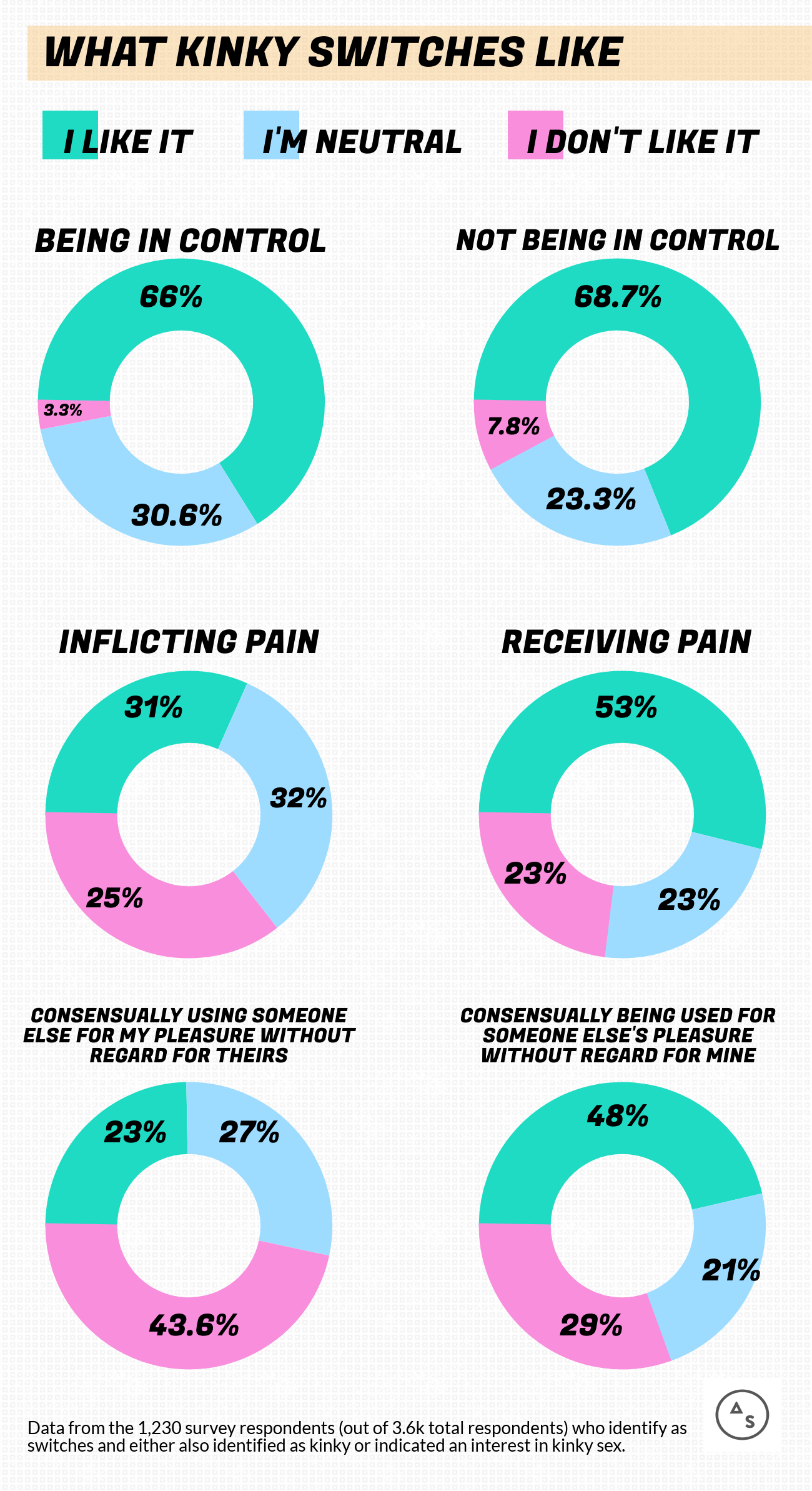
What’s interesting is that the not liking a thing is when switches tend to line up with tops, moreso than the liking of a thing. 25% of tops don’t like inflicting pain; neither do 25% of switches. 45% of tops and 43.6% of switches don’t like consensually using someone else for their pleasure. 1% of tops don’t like being in control — neither do 3.5% of switches. It doesn’t line up quite as well with bottoms, but it’s not too far off either.
In consultation with our former NSFW editor Carolyn, we decided to separate kinky switches from all switches, so only kink-identified survey-takers were subjected to an additional survey page with questions about dominants/submissives and sub-identities therein.
![]()
How Many Kinky Switches Are Out There?
Switching: also the most popular identity for kinksters!

16.2% dominant, 35% submissive, 41% switch, 4.9% none of the above, 2.9% I’m Not Sure.
Of the 1,909 switches on our survey, 358 identify as kinky. 68.6% of those switches identify as switches within a kink context, 17.6% as submissives, 7.7% as doms, 4.3% as “none of the above” and 2.3% are not sure. So the “dom shortage”/”sub surplus” we talked about last week comes from a few areas: more bottoms than tops identify as kinky and the ones that do are overwhelmingly likely to be submissives, and more switches identify as submissives than dominants.
What Does It Mean to be A Kinky Switch?
Kinky switches reported a wide range of experiences for how switching played out in their sexual lives. “I really enjoy both domming and subbing when it comes to sex,” wrote one bisexual femme. “In the rest of my life, I absolutely want an equal relationship with everything and would be very uncomfortable with any kind of general power exchange, but I find power like a fine wine — it feels delicious, and there’s something really beautiful about someone surrendering to me and obeying my orders. But I also really enjoy giving up control. Bottoming is one of the only times in my life I ever really stop worrying about everything and only worry about pleasing my partner. With the right top, it quiets my anxieties and makes me feel so warm and cared about.”
“I’m currently in a D/s relationship where I am the sub-type person and am mostly subbing lately,” wrote a queer femme. “But I have experience and desires that revolve around dominance as well, hence my identification as a switch.”
Although our survey was specifically about sex with people who don’t identify as cis men, a few switches told us in the open response area that they top men but bottom for women. “Bottoming and subbing for women makes my gay little heart quiver with joy,” wrote one. “Topping/domming men is pretty rad too.”
Some switch within their present relationship, like the queer non-binary tomboy femme who told us, “My partner and I switch roles, sometimes in the same session, depending on how we’re feeling that day. She leans more subby than I do, so I end up domming more often.”
Other times the switching is act-specific. “In general, I really like to dominate my partners verbally, but am not that into inflicting pain (unless a partner really likes that),” wrote a gay femme. “Conversely, I am fairly neutral about being dominated, but do like to receive pain (having my ass slapped, cunt spanked, hair pulled etc). Receiving pain isn’t as much about D/s for me as it is about sharpening sensation so I can get out of my head and be present in the moment. It feels like turning off my brain, and grounding myself, via my body. ”
“When it comes to power I prefer domination,” wrote a poly genderfuck woman. “but when it comes to sensation I’m versatile. Different folks bring out really different strains of feeling for me.”
Or, kinky switching is an active role throughout the encounter. “I like switching ~itself~ as a sex act/move/style!” Wrote a queer soft butch switch. “Like, ‘oh you thought you were in charge? Surprise I’m in charge now’ – or conversely, ‘oh shit that thing you started doing really put me in a different place and now i would do literally anything you tell me and am receiving fully any idea you get or act you choose’ I love that push & pull.”
![]()
“None of the Above” vs. Switch
A question I got repeatedly when sharing the survey results with friends was “what’s the difference between None of the Above” and “Switch?” Isn’t it the same thing?”
Well… no.
As with most things that involve LGBTQ+ people, someone’s attachment to not labeling themselves is often just as meaningful and important to them as someone else’s attachment to labeling.
Many said their communities or relationships didn’t use top/bottom/switch terminology, others seemed a little bit mad at me, some were frustrated by the terms’ popularity and others were excited to learn more about these identities despite not feeling personally drawn to them. 7% of NOTAs used to identify as tops, 7% as bottoms, and 11% as switches; but 81% have never used any of these terms.
Most who provided additional commentary on their none-of-aboveness could be split into five camps of thought:
1. These terms aren’t appropriate terms for how lesbian & queer women have sex because [they’re for gay men, they’re kink-specific, they’re phallocentric, they require penetration, etc.]
“I’m not a ‘I don’t do labels’-believing person,” wrote one bisexual woman, “but these terms are all really and completely something I would never use even if I were a gay dude/super into BDSM. Yeah there are simple honest preferences, but there’s also the weird homophobic/misogynistic background of dividing ‘roles’ since at least the ancient Greeks.”
Another queer woman wrote, “Honestly, I’m not sure why the queer women’s community has adopted these terms, and I’m partly taking this quiz out of protest against the appropriation of gay male vernacular when queer women already had words for this.”
“I feel like it’s an attempt to make queer sex imitate or identify more with straight cisgender sex,” wrote another queer woman.
2. The kind of sex I have is too fluid for bottom/top/switch terminology.
“No relationship I’ve ever had has required one of us be designated a penetrator or one who is penetrated,” wrote the same queer woman I just quoted. “And that’s what I think is wonderful and beautiful about queer/lesbian sex, that there are no rules or requirements of how things are ‘supposed’ to be.”
“I prefer less control and [my partner] prefers more, but neither of us identifies as one or the other, and we both ‘give’ and ‘receive’ equally,” wrote one bisexual femme. “‘Switch’ feels like an identity where you’re flexible on being a top or bottom, but doesn’t really capture the in-between.”
“Sex is collaborative, and while those terms don’t denote otherwise, I think that oftentimes the mindset is that sex is being done to someone rather an a collaborative, cooperative act,” wrote a non-binary queer person. “That’s why I don’t like these terms.”
“In my experience, folks tend to describe and explain what they are into sexually rather than use a label to describe those sexual preferences,” said another queer woman.
3. I use these terms in kink, but not outside of it.
“If I’m having kinky sex then certainly sometimes these roles/terms apply,” wrote a bisexual genderqueer who identifies as a switch within a kink context, “but in the context of non-scene sex, I often don’t fall into only one role.”
“I strongly dislike the confines of sexual roles outside of a kink dynamic,” wrote a bisexual woman. “Kink & sex are two separate things that fulfill different needs and desires for me. Sex should be approached as fluid, active, engaged, and new and different every time.”
4. I’m still figuring it out.
Although “I’m not sure” was an option, some who felt unsure about their identification seemed to choose “none of the above” because uncertainty itself wasn’t their primary hesitation to identify.
“I like to say ‘I bottom in my current relationship,’ because I do — but that doesn’t *make* me ‘a bottom,'” wrote a survey-taker who didn’t finish their survey. “I want to explore my dominant side as well. I don’t consider myself a switch because I haven’t had the opportunity to see if I like topping yet.”
5. I identify with a term not included here.
This was most often “vers,” but sometimes were kink-specific terms. (At that point in the survey, survey-takers weren’t yet aware that they’d have a chance to talk about kink identities later in the survey.)
“I really don’t like these labels,” wrote a kinky NOTA about top/bottom/switch. “They’re just close enough to kink to be confusing without some of the clarity of most bdsm labels. Sometimes people think they mean your role in specific sex acts, sometimes they mean kink and it’s really unclear.”
![]()
What Do “None of the Aboves” Like to Do in Bed?
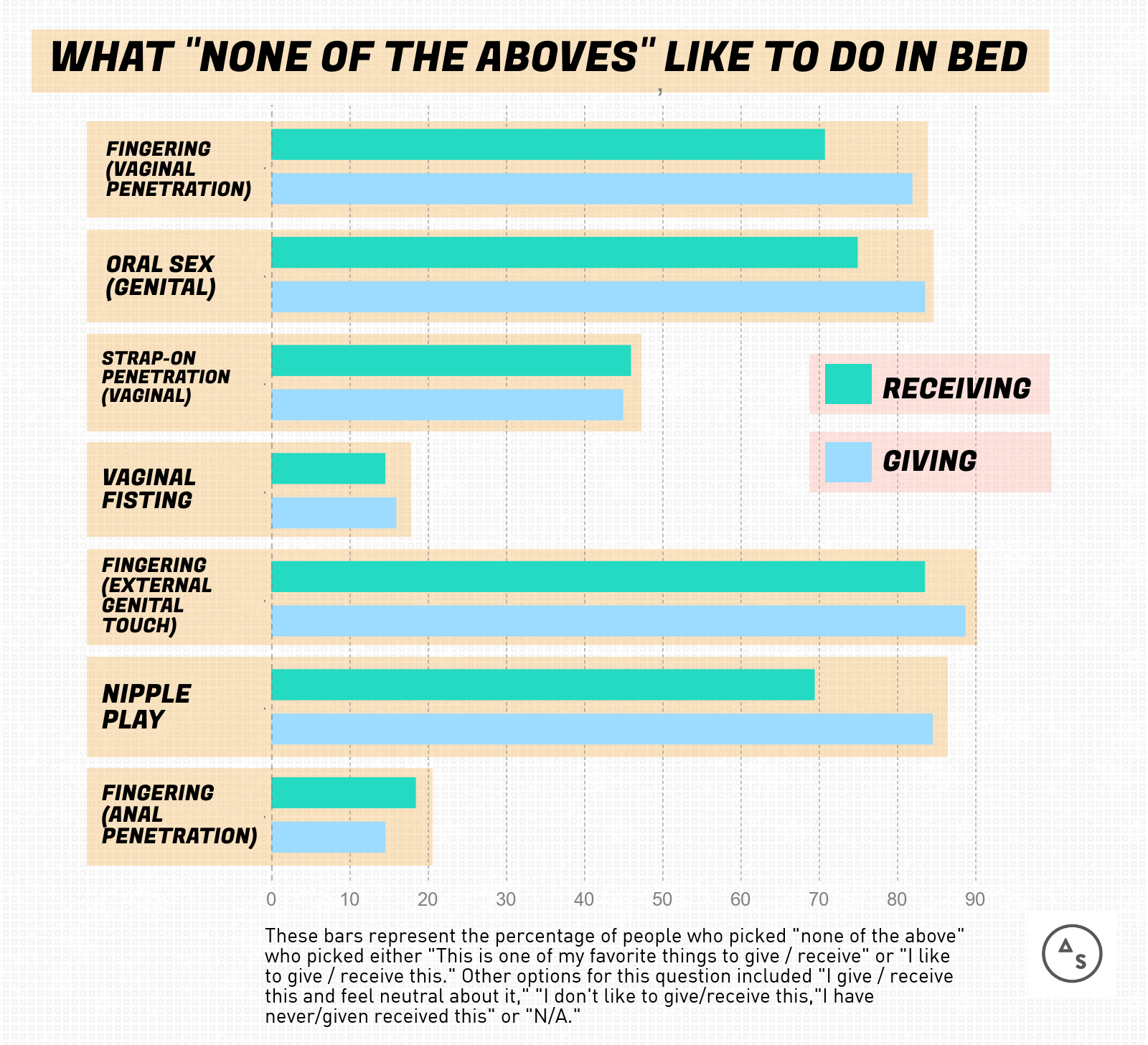
There weren’t any dramatic differences here between NOTAs and other groups. Smaller percentages of “none of the above” survey-takers were fans of various sexual activities than tops, bottoms or switches, but it’s also possible that NOTAs indicated less affiliation for those activities due to feeling distance from giving/receiving dynamics in general. Strap-on penetration had the biggest consistent disparity — around 44% of NOTAs were into giving or receiving it, compared to 72% of tops who like giving it, 65% of bottoms who like receiving it, and around 55% of switches who like to give or receive it.
![]()
None of the Aboves & Kink
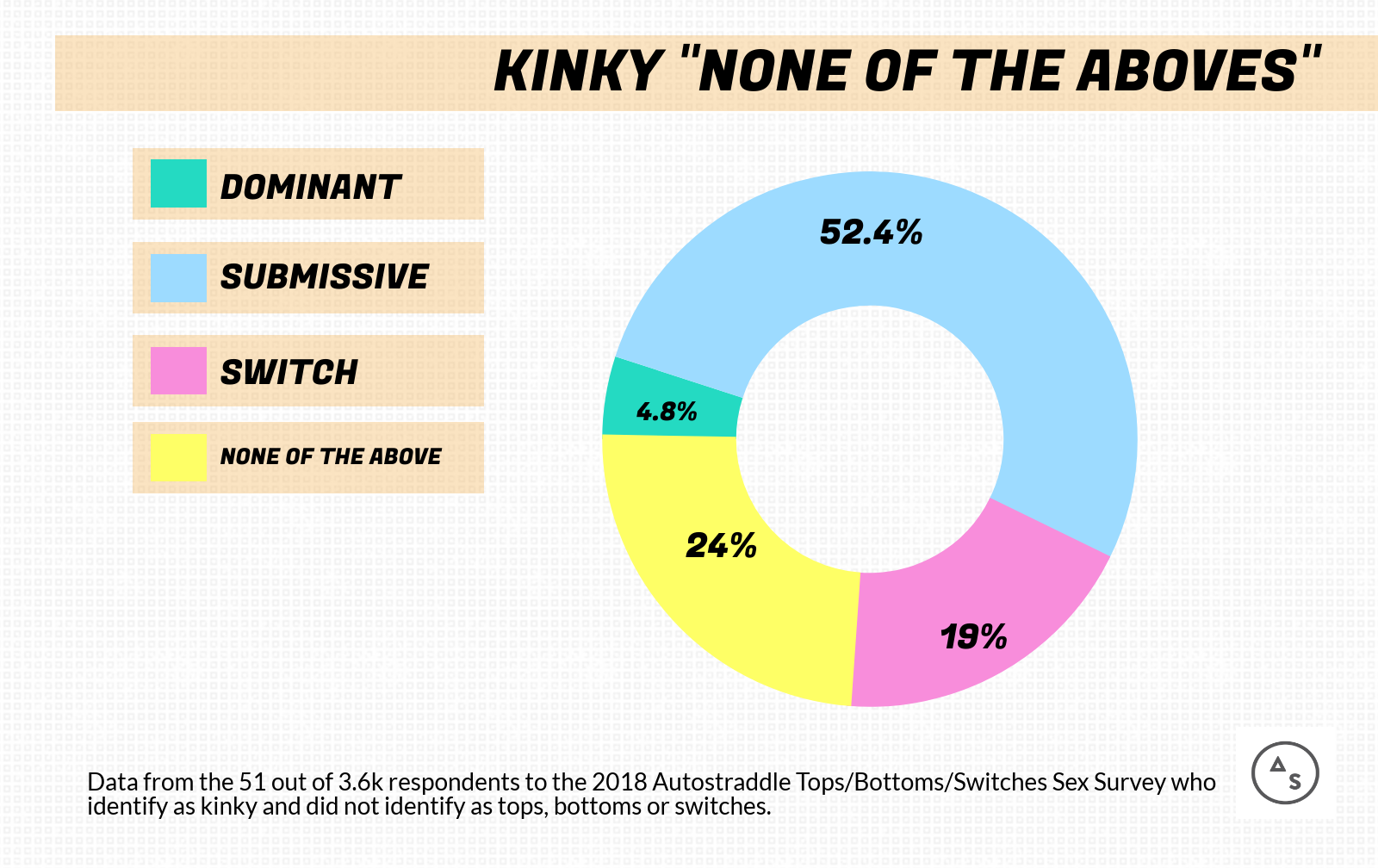
NOTAs were way more likely to not identify as kinky or like kinky sex than other survey takers — 45.2% weren’t into kink at all, compared to 21% of tops, 14.7% of bottoms and 17.6% of switches.
That leaves us with 51 kinky NOTAs to overanalyze. For some, their resistance to top/bottom/switch labels were tied entirely to their relationship with kink. “Tops in the bedroom,” wrote one queer hard femme, “bottoms in the dungeon.” It seemed more than a few had picked “none of the above” for the earlier question because submissive, not “bottom,” was their chosen term, leading us to yet another area where we see the causes of the aforementioned sub surplus.
“I am a sucker for butchy top energy,” wrote another kinky queer woman who said she wasn’t into identifying with any specific term. “Like, I’ll submit so damn hard for a butch in boots, I’ll meld with the floor if that’s what they ask for… I pride myself on being a really good submissive, but sometimes when my wife and I are feeling kinky & playful, I’ll be a snarky brat on purpose and try to goad her into being stern and forceful with me. *swoon*. On the flipside, misandry is a huge turn on for me and when I picture myself in power it’s usually exerting control over a cis hetero male.”
One switchy kink-identified genderqueer woman also identified as a “vers,” which she defined as “someone who finds sexual satisfaction through giving AND receiving pleasure! Verses are NOT half tops and half bottoms they are their own majestic creatures.” Earlier in the survey, she declared, “Verses are absolutely 1000% the best sexual partners on the planet. Vers 4 Vers till the day that I die.”
![]()
Finally: Some Thoughts for You From Some “Nones of the Above”
“I am uncomfortable with those labels used in the context of sexual encounters that do not involve cis men,” wrote one queer woman. “For me, the magic of queer sex is to overcome the feminine/masculine binary, and I feel that using the top/bottom labels we are going back. But maybe the answers of this survey change my mind ;-)”
Another asked for this: “Can we talk more about categories and classification and historical impact and why categories might be weird and why we are attached to them??”
Personally, I take a “you do you” approach to all of this. If a label holds meaning for you, then by all means, embrace it. If it doesn’t, then it doesn’t! I like them. I love the memes and jokes we make around these terms (e.g., “In a Movie Full of Tops, Who Has the Most Top Energy in the Ocean’s 8 Trailer?“) and find it to be useful shorthand, but it’s clear that also not identifying with any of these terms is valid as fuck.
C U Next Tuesday to talk about sub identities! (E.g., “bratty bottom,” “pain switch,” “service tops”)
Lesbian Sex 101 is Autostraddle’s series on how to have lesbian sex for queer women and anyone who finds this information applicable to their bodies or sexual activities. Employment of the term “lesbian sex” in this post uses “lesbian” as an adjective to describe sex between two women or people who identify with that experience, regardless of the sexual orientation of the two people involved.
Sex ed almost never includes queer women or our experiences, so we’re exploring pleasure, safety, relationships and more to make that information more accessible.
A lot of the language in these posts is intended to make them easy to find on search engines.Some of the body parts we talk about will be yours or your partners’ and some won’t. Some of the pronouns will be yours or your partners’ and some won’t. Some of the sexualities will be yours or your partners’ and some won’t. Some of the language will be yours or your partners’ and some won’t. Take what you want and what applies to you or what you can make apply to you and your partners and your experiences, and leave the rest!
55 Very Deep Thoughts About Your Sex Life You Shared With Us On Our Recent Sex Survey
About a month ago we solicited your participation in a survey about the way top / bottom / switch terminology is used (or not!) within queer women & trans folks’ sexual lives and communities. There were plenty of opportunities within the survey for you to share not only your choice-from-multiple options, but also your open-ended answers.
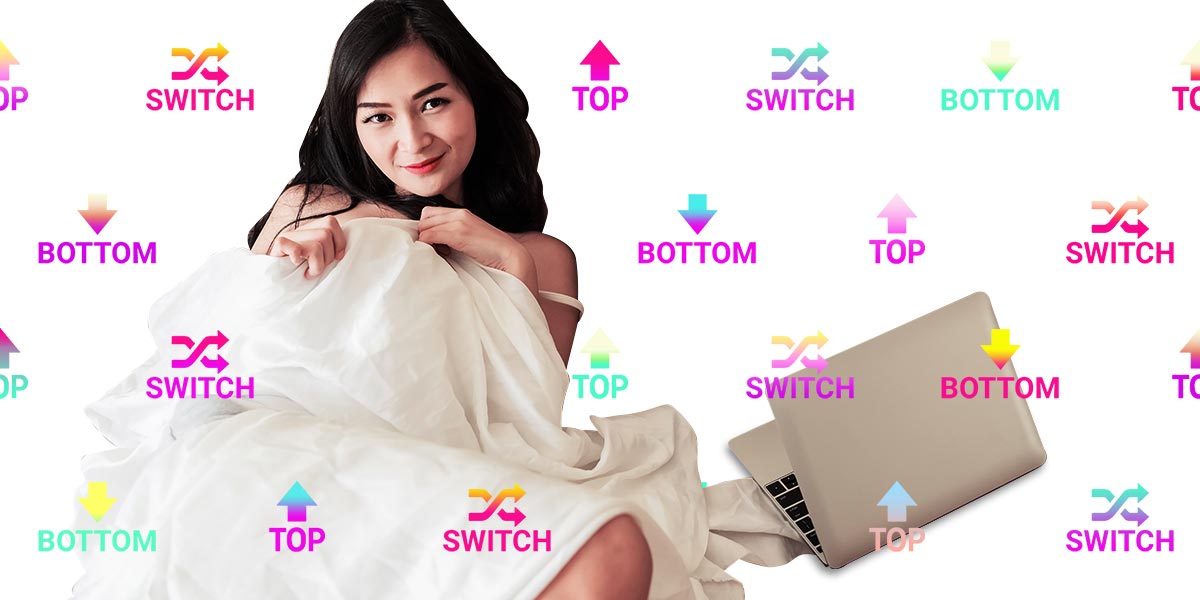
For example, you were free to tell me what your identification as Top, Bottom, Switch or “None of the Above” meant to you. I asked “anything else you wanna tell us about how you have sex” on page three, and at the end of the survey I asked “anything else you wanna tell us?” Mostly you told us that you love Autostraddle, which, thank you so much; or reminded me that St. Paul erasure is a problem that I was perpetuating by writing Minneapolis instead of “Minneapolis/St.Paul” and you know what, thank you so much, I did not know that! (And for the record, I’m from the Midwest, so.)
So, the sentences below were ripped mercilessly out of context from your open-ended answers to questions about your sexual behavior and identity as well as questions about how you would define various sexual terms. I have turned fragments into complete sentences and made spelling corrections when it felt like the right thing to do. Please note that the inclusion of an idea on this list is not an endorsement of that idea.
1. I think we should bring back the term ‘Kiki’ for switch ’cause it’s cute
2. I am a Gemini who can’t keep their mouth shut even during oral
3. My ex really wanted ass stuff done to her, that’s why she’s my ex
4. A former sub of mine once described me as “Xena the Warrior English Teacher.”
5. YES I’ve been dying to tell someone about how my partner and I finally found a name for our new dildo and it’s Antoni
6. I’m so happy I’m a lesbian.
7. I’m married now and my wife would say I am a bottom. In fact, when we wrap up our leftover pizza, she always puts mine on the bottom for this reason.
8. I didn’t realize how boring my wife and I are so….thanks? STONEWALL WAS A RIOT
9. in this hell timeline, have as much queer sex as possible. anything to make life worse for mike pence and better for us <3
10. If I don’t focus and mentally force myself to come, I can’t. Doesn’t matter how much stimulation I’m receiving or how good it is, if the conscious decision isn’t there, I just don’t orgasm. Believe me, plenty of past partners have taken that as a challenge. Need someone’s ego deflated? Your ex thinks they’re god’s gift to sex? I am now taking commissions!!
11. Its always better when Beyonce is playing. (Self titled album of course, I’m not a monster)
12. Also I misread “pain switch” as “pain witch”, so i identify as that, now, obviously.
14. Being a top means that I don’t wear pants
15. pillow princesses are braver than the US marines
16. I love my tiny top girlfriend!
17. “i am a bottom and also an alpha which means i don’t mind getting dunked on as long as you recognize i jump higher than you.” @hellenorosevelt said it first.
[ed. note: please note that our dear friend hellen added “@hellenorosevelt said it first” to her own open-ended response, that was not an editorial addition.]
18. I’m a big angry femme top really into shy butch bottoms
19. I mommy domme more often these days. I think my subs are looking for a place of comfort in this terrible time.
20. Oh god, I don’t know what any of these words mean! I’m about to turn 30, is it happening? Am I becoming one of these endearing old gay men trying to understand the words the young gays are using?
21. I LITERALLY DONT UNDERSTAND WHAT THESE TERMS MEAN IN THE CONTEXT OF LADIES GETTING IT ON. PLEASE HELP ME!!!!!
22. … the sex we have is just the sex we have, you know? So I’m kind of taking a stab in the dark with all of these questions. I guess it’s a survey and that’s kind of the point but I can’t help but feel like I’m going to be graded! F ON GAY LINGO, I WILL NEVER GET MY LESBIAN DEGREE NOW. That said, I guess I’m a top.
23. You know that episode of the L Word when they are on the cruise, and Shane and that author sneak away to hook up, but then realize they are both tops and decide to not actually hook up, but just tell everyone they did? That’s happened to me a few times.
24. The L Word taught me queer relationships are all switchy did they lead me astray?
25. I love making my partner feel good but sometimes my jaw / wrist / face aches HELP
26. Once I was receiving a glorious fisting, and I was being so vocal that the dogs figured out how to open the bedroom door to check that I was okay.
27. one of my cats likes to lay right next to my partner and i while we get it on. she just stares at us and purrs. cats are weird and also kinda creepy huh?
28. A month ago, a cis guy I had been dating for 3 months broke up with me via text SPELLING MY NAME WRONG and that sex was great, but WOW I’m I glad to be fucking within my standard queer group of “women and nonbinary folks (regardless of genitalia)” now
29. Most of the time I feel like a top but sometimes I want an Amazon to throw me over her shoulder and carry me back to her place.
30. The way I have sex is like a tornado in a bottle, analogously intense and all-consuming but without the destruction and death
31. Lately we keep having sex after watching movies with lesbians. This was started after we watched Carol. It’s quite an enjoyable trend.
32. I’ve had a moment where every ex I’ve dated in my town was in the same room talking to each other. Don’t date in a small town.
33. God I miss women and I have no idea what I’m doing with my life.
34. My arms are WEAK and I get TIRED on top
35. Sometimes I do her, sometimes she does me, sometimes we do each other at the same time….and sometimes we just drink a beer and cuddle because that’s awesome too
36. Be gay, do crimes!
37. No butt stuff
38. Spring comes around and it has to be EVERYDAY
39. Sex is usually something people delude themselves into believing is for mutual care when it is more often about inflicting mutual suffering, exploiting another person to participate in petty and pointless psychosexual dramas. And too many are iffy on the mutual part.
40. I want murder
41. Well!
42. I am 100% switchy for life. My wife is a bottom. This sometimes causes tantrums
43. My gf and I are both bottoms so it’s a CONVERSATION.
44. My girlfriend and I have made a few jokes recently about what counts as topping and about what either of us are because for the first two months of us being sexually active, we each thought of ourselves as tops and the other one as bottoms
45. Wasn’t on the list above but to be clear we don’t scissor. We tried it once and it DID NOT work for us.
46. I love to scissor, I can’t believe you didn’t include anything humping related on this survey. Sometimes when I grind up on my girlfriend’s thigh I think “thank god I’m a lesbian”
47. In response to “How would you define “switch”?”
“You know the Will Smith song “Switch” from 2005? It’s like that”
48. In response to “How would you define “top”?
“It’s a me, Mario”
49. My girlfriend is so attractive that I still get nervous and don’t initiate sex as much as I would like to
51. Autostraddle makes my heart go mushy and I have crushes on like 90% of your writers
52. Filling out the rest of this survey was weird enough for me, my catholic upbringing is cringing at seeing this all on paper. This is how much I love you guys. You’re welcome.
53. I would define “bottom” as the person “receiving”? Maybe? Honestly I wondered if I should Google, but didnt want that search on my work internet server
54. now I’m distracted thinking about sex and can’t focus on my work THX GUYS
55. I can’t really think of any specific other terms I use to describe how I have sex. But I’m sure I’ll think of several as soon as I submit the survey.
What Does It Mean to Be a “Top” or a “Dominant” in Lesbian Sex?
Hello and welcome to part two of our series on what the hell we mean when we say “top,” “bottom” or “switch”! Last week we talked about bottoms and submissives, and this week we’re talking about tops and dominants. Let’s get into it.
![]()
The Tops, Bottoms and Switches Sex Survey
Three weeks ago, I presented you with a survey about these slippery words, and over 3.6k people showed up to share their tops and bottoms with me. These are the demographics of the respondents:
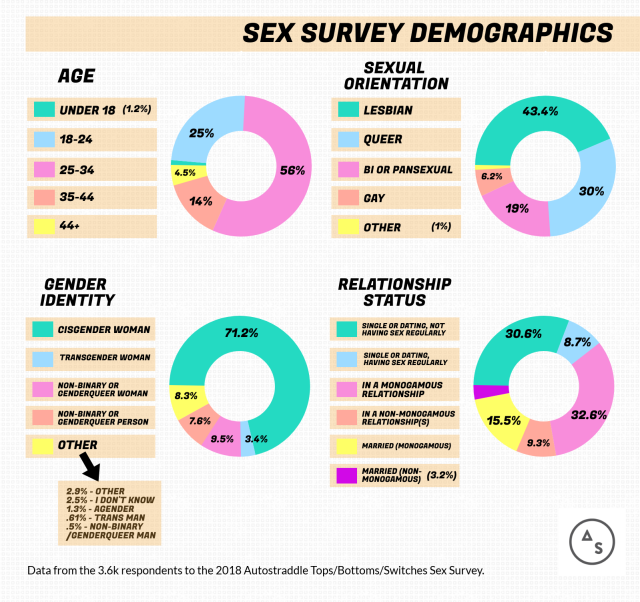
Demographics of Sex Survey Respondents // Age: Under 18 (1.2%), 18-24 (25%), 25-34 (56%), 35-44 (14%), 44+ (4.5%) // Sexual Orientation: Lesbian (43.4%), Queer (30%), Bi or Pansexual (19%), Gay (6.2%), Other (1%) // Gender Identity: Cis woman (71.2%), Trans woman (3.4%), Non-Binary or Genderqueer Woman (9.5%), Non-Binary or Genderqueer Person (7.6%), Other (8.2%) // Relationship Status: Single or Dating, Not Having Sex Regularly (30.6%), Single or Dating, Having Sex Regularly (8.7%), In a Monogamous Relationship (32.6%), In a Non-Monogamous Relationship (9.3%), Married & Monogamous (15.5%), Married & Non-Monogamous (3.2%)
I’ll be going through the data gradually over the course of the month — next week we’ll talk about switches and people who don’t employ these terms at all. We’ll also talk about sub-identities (bratty bottom, power bottom, service top, etc.) and we’ll look at the data as a whole and how it intersects with various identities and demographics. Each week’s data will build on last week’s and will be very satisfying for nerds and fans of sex.
How Many Tops Are Out There?
Despite all the talk of tops and bottoms within the queer community, our survey revealed that people who identify specifically as tops or bottoms are in the minority overall. Also, there are slightly more bottoms out there than tops.

Tops: 12% // Bottoms: 14.3% // Switches: 51.6% // None of the Above: 13.4% // I’m Not Sure: 8.9%
What Is Topping?
Before queer women’s culture adopted top/bottom as terminology relevant to non-kinky sex, the terms were primarily used by gay men, or in kink or BDSM contexts by both straight and LGBTQ+ people. For now, a few things are clear from our surveys: “top” is easier to define than “bottom,” there’s more consensus on favored acts among tops versus bottoms, and there seems to be a more clear-cut distinction between “top” and “dominant” than between “bottom” and “submissive.”
![]()
What Do Tops Like To Do In Bed?
We asked survey-takers to indicate their passion for giving and receiving a variety of sexual acts, and also asked them to define what “top” means to them. We’ve included some of the most popular activities below. (Note that scissoring/dry-humping was not included on the survey as it has no clear giving/receiving dynamics.)
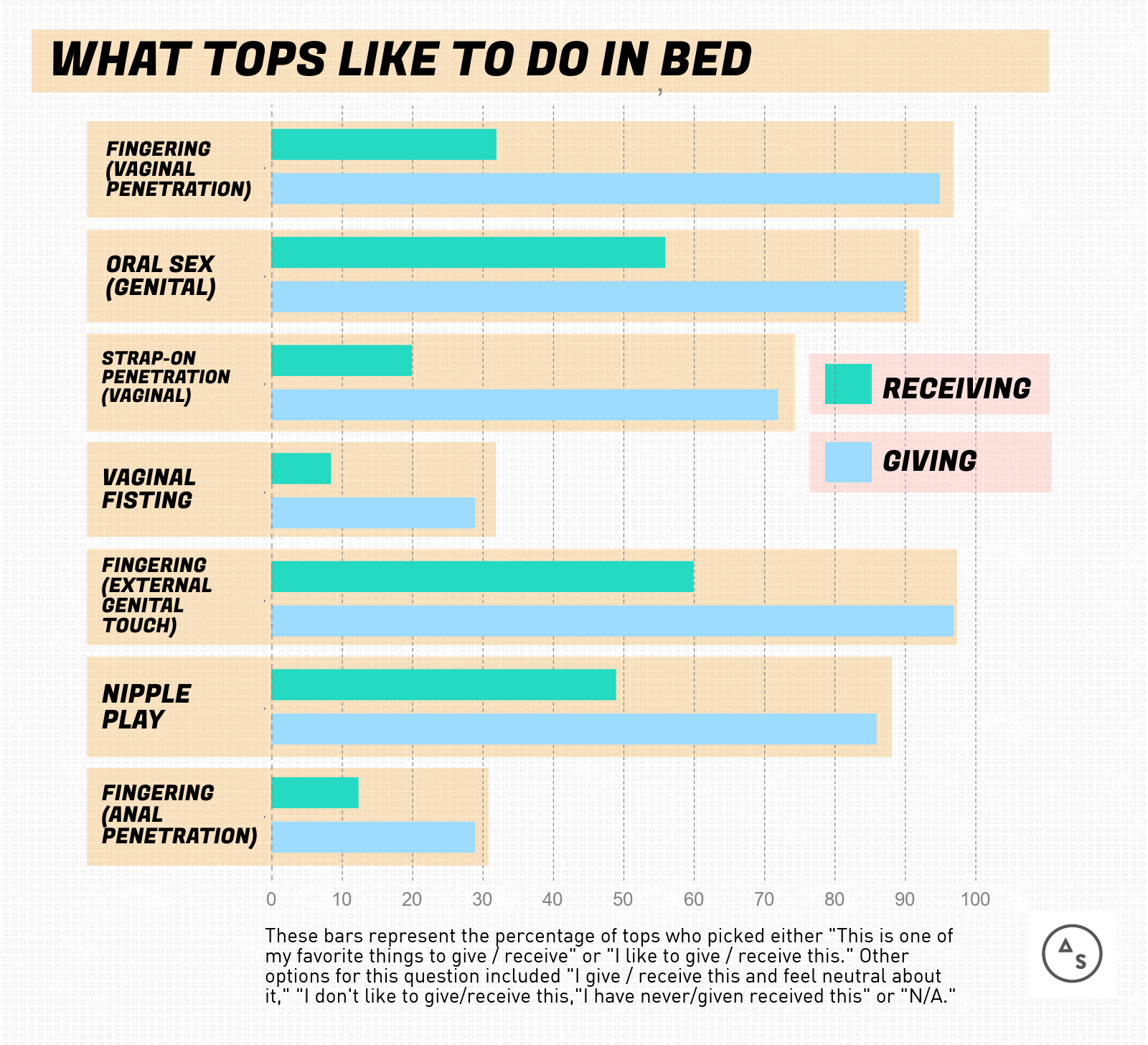
WHAT TOPS LIKE TO DO IN BED – Vaginal Penetration: Receiving (32%), Giving (95%) // Oral Sex (Genital): Receiving (56%), Giving (90%) // Strap-On Penetration (Vaginal): Receiving (20%), Giving (72%) // Vaginal Fisting: Receiving (8.5%), Giving (29%) // Fingering (External Genital Touch): Giving (97%), Receiving (60%) // Nipple Play: Receiving (49%), Giving (86%) // Anal: Receiving (12.4%), Giving (29%)
The chart above reveals which activities inspired tops to declare “this is one of my favorite things to give/receive” or “I like to give/receive this.” They could also express neutral feelings about a given act, say they didn’t like to do it, say they’d never done it or pick “N/A.” But “I give this and don’t like it” was selected very rarely — exactly zero tops explicitly don’t like giving vaginal penetration, for example, and the only sex acts that inspired more than five tops to pick “I give this and don’t like it” were anal oral sex (six respondents don’t like it) and anal penetration (seven respondents don’t like it).
There was a greater consensus among tops versus bottoms when it comes to preferred acts. For example, 95% of tops like to penetrate vaginally; 80% of bottoms like to receive said penetration. Of course, it’s worth noting that not all people who took this survey have vaginas to penetrate, but removing the group least likely to have a vagina (trans women) from our bottom data did not make a statistically relevant impact on that percentage. The very definitions of “giving” and “receiving” lend themselves to greater top consensus for, as it was written Pat Califia’s 1988 lesbian sex guide Sapphistry: The Book of Lesbian Sexuality: “[the top’s] power is always limited by the needs and capabilities of the bottom.” Similarly, there are far more bottoms interested in finger-fucking (68.6%) than there are tops who want to get finger-fucked (32%).
![]()
So, “Topping” Can Mean…
Being in Charge of the Encounter
The most consistent descriptor in the open-form answer descriptions was that of the top being “in control” or “in charge” of the sexual encounter, or otherwise “leading the way” or being the “more active” or “dominant” partner. “You primarily enact, direct, or conduct the activities,” said one butch top. “Someone who is the team captain for the activity,” wrote one bisexual top, adding: “Someone who often initiates or lovingly takes control. Someone who is taking on the responsibility of giving the other party or parties a very good time.”
“Emotional leadership labor trumps physical action here,” wrote a queer femme dominatrix regarding her definition of “top.” “Often a top is the one fucking, etc. but a top can be licked or fucked or whatever if they are controlling the scene.”
Preferring to Be The Penetrator or The Giver
In gay men’s sexual culture, tops penetrate and bottoms are penetrated, which came up a lot in respondents’ definitions, too. One tomboy femme lesbian top described tops as “the partner on the giving end of sex, whether that be oral, penetrative, digitally penetrative, etc.” As the above chart shows, tops were much more interested in receiving external stimulation (oral or digital) than penetration, although many tops enjoyed penetration as well.
“The top is the more ‘active’ partner in bed, the one who wears the strap on and likes to do ‘the fucking’ even if the bottom is saying exactly what she wants done,” said one lesbian femme top.
“The giver,” which is also the title of a good book and a bad movie, was another popularly employed phrase. Tops were frequently described as “being on the giving end of sex.” Which brings me to…
Giving But Not (or Rarely) (or Secondarily) Receiving
Although the only word that means “does not want their genitals touched” is “stone,” a few survey-takers seemed to assign a level of “stone” to topping. One soft butch gay woman defined “top” as “someone that strictly ‘gives’ and does not look to be touched in any way,” but most descriptions focused not on giving exclusively but rather on preferring or prioritizing giving. “She will give and receive,” wrote one queer tomboy, “but would be ok just giving.”
Getting Off On Getting Somebody Else Off
The “giving” dynamic isn’t just about preferring to perform specific sexual acts, it’s about deriving pleasure from doing so. “Tops prefer to give sexual pleasure more often than they receive it,” wrote one gender-fluid Stud/AG. A tomboy femme top described topping as “someone who gets pleasure from giving as much as receiving, if not more.”
A top “gets pretty close to comparable amounts of enjoyment out of getting a partner off as themselves getting off,” wrote one soft butch top. Another soft butch lesbian top described her topping as “preferring to touch rather than be touched for pure sexual and emotional excitement and fulfillment.” Yet one more soft butch lesbian top wrote, “When I say I am a top, I mean I am a person who primarily experiences sexual pleasure by touching my partner rather than having my partner touch me.”
The lesbian femme top I quoted in an earlier section wrote that sex isn’t about coming for her — “if I want to get off, I’d rather masturbate.” Although sex isn’t about coming for a lot of people, regardless of top/bottom identity, for those who want orgasming to be part of sex, “the bottom comes first” might be a part of the dynamic. Along those lines, a bisexual lazy femme/soft butch top described her position as the “person who likes to be more dominant and is focused on giving pleasure and turned on by that (usually comes after their partner).”
Kinky Tops and Dominants
25% of tops identify as kinky (compared to 40% of bottoms and 27% of switches) and 53.5% said they don’t identify as kinky but sometimes enjoy kinky sex (compared to 46% of bottoms and 27% of switches). Within the world of kink, “topping” has different connotations than it does for vanilla sex. According to The New Topping Book, which is focused on BDSM play specifically, “top is an umbrella term that includes people who like to play on the giving end of sensation and pain, bondage, control and discipline and all the other activities that make up the universe of BDSM.” In a kink context, “dominant” is one of many terms enveloped by that particular umbrella.
What Do Kinky Tops Like?
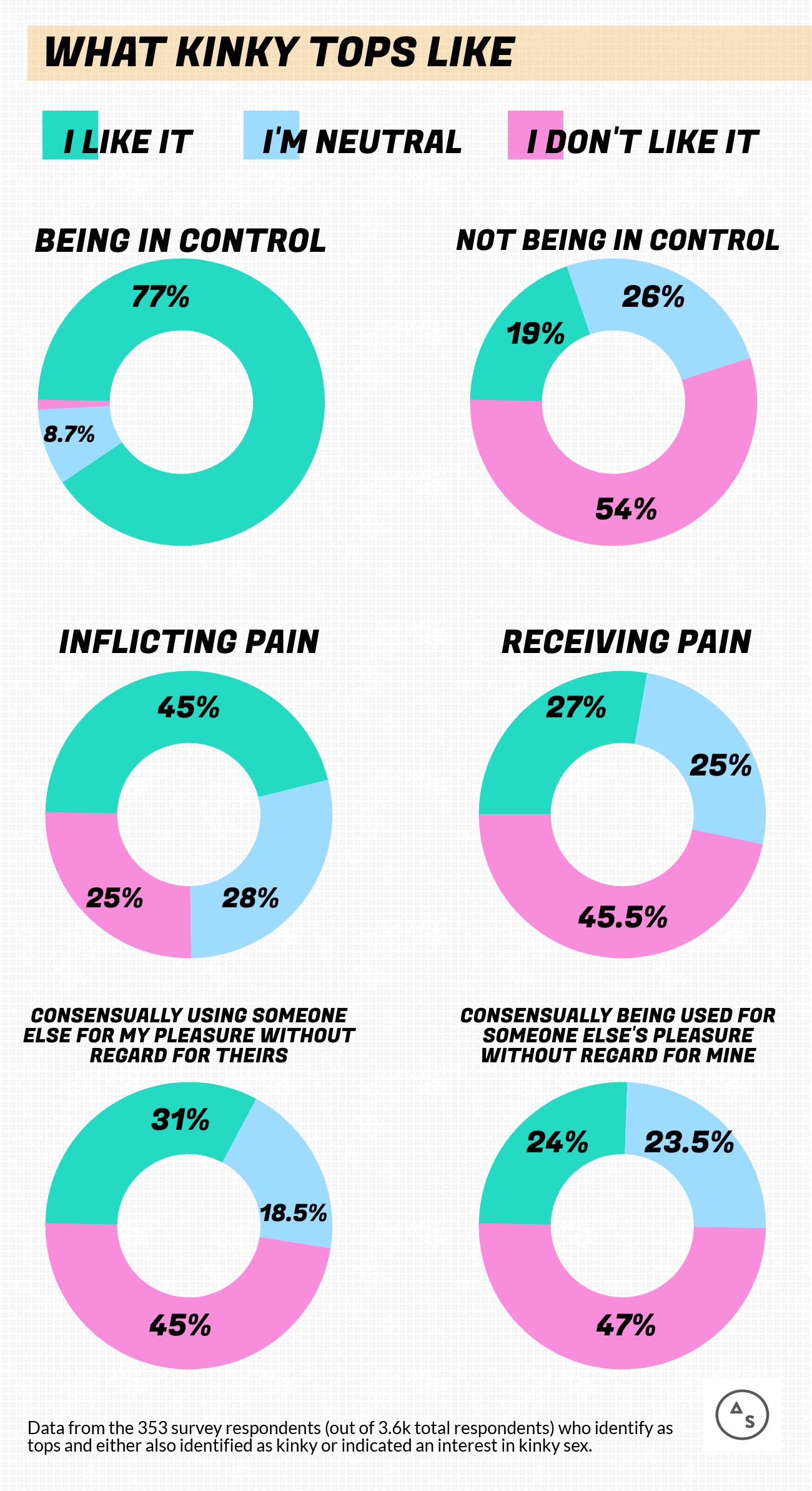
In comparison to the above data, 6% of non-kinky tops like inflicting pain and 3.8% like using someone else for pleasure with no regard for theirs. However, a full 86% of non-kinky tops also like being in control of the sexual experience, which is a very small disparity (4%!) compared to the disparity amongst kinky and non-kinky bottoms — 91% of kinky bottoms like not being in control, compared to 62% of non-kinky bottoms. The vulnerability inherent in “not being in control” would seem, then, to be less favored overall than its reverse, and perhaps less intrinsic to vanilla “bottoming” than being in control is to vanilla “topping.”
Within the context of kink, what separates the concept of “top” from “dominant”? In consultation with our former NSFW editor Carolyn, we decided to separate “tops” and “dominants” on our survey. Only kink-identified survey-takers were subjected to an additional survey page with questions about dominants/submissives and sub-identities therein, and now we’re gonna talk about those results.
![]()
How Many Dominants Are Out There?
Of the 435 self-identified tops on our survey, only 115 identify as kinky, and only 87% of those (92 people total) as dominants. Meanwhile, of our 525 bottoms, 190 identify as kinky, and 172 as subs — meaning that subs outnumber doms 2:1. 3.4% of kinky tops identify as submissives, 8% as switches and 2.24% as “none of the above” or “not sure.”

DOMS / SUBS / SWITCHING: 16.2% Dominant, 35% Submissive, 41% Switches, 4.9% none of the above, 2.9% I’m Not Sure
So, is the alleged Dom Shortage real? According to Carolyn: “On one hand, talking about a ‘Dom shortage’ implies a sort of commodification of Doms that turns subjects into objects; leads to objectification; and belies the fact that among people of any sexuality it’s challenging to find a person who is a skilled and respectful counterpart to whatever sex or play you’re trying to have, who is good at communicating, whose relationship orientation matches up with yours, and who you also find hot intellectually and emotionally and sexually in both immediate and deeper ways. And on the other hand, totally.”
Since we’re here anyway, I feel inspired by a higher queer power to also note that concepts like “dom shortage” and “top shortage” (which are often exhaled in the same breath as concerns over a so-called “butch shortage,”) create a paradigm of scarcity that can easily influence those seeking tops or doms to feel a certain level of desperation or ambient cultural anxiety that leads one to hang onto their top for dear life, against all odds, even when the odds are immense. The New Topping Book states this plainly to its top readership: “if you’re a heterosexual female, a lesbian, or a gay man… you as a top are in something of a buyer’s market.” If you’re a seller slash bottom, I encourage you to think critically about these ideas, be as picky as you damn well please while at the market, and never underestimate a suitable switch.
Why Is There a “Shortage” of Kinky Tops and/or Doms?
Here’s three theories:
1. Gender Stuff
Research of BDSM practitioners has shown women tend towards submission and men towards dominance and that women are more likely to be aroused by masochistic thoughts than men, who are more aroused by sadism. You’d expect those numbers to shift at least somewhat for queer women, and indeed they do — the aforementioned study revealed 8% of kinky women were dominants, and on ours, 16% of kinky cis, trans and genderqueer-identified women enjoy domming. Still, even with double the amount researchers found amongst (presumably?) straight women, the numbers remain skewed. The tendency towards subbing and away from domming was also reflected in our gender breakdown: 84.3% of our survey’s subs identify as women (cis, trans, or genderqueer), compared to 74% of doms, and non-binary people and agender folks were more likely to be doms than subs. But! Gay men seem to feel they have a top shortage as well, so maybe nothing means anything?
2. Learning Curve
Being a submissive certainly requires a great deal of work, including psychological preparation, building trust, understanding your boundaries, familiarizing yourself and testing your interest in various sexual options, reading your body and a developing effective methods of communication. Being a dominant, on the other hand, requires a lot of practical skill-building — from how to safely inflict pain to the literal knowledge of knots for rope bondage. It can be more intimidating to just declare oneself a dom, regardless of experience level, and go for it than the reverse. Cee, a non-binary dom I talked to while writing this post, recalled realizing pretty early into feeling dommy that it wasn’t something they could just do, they had a lot to learn to make sure they didn’t physically harm their partner. On our survey, doms were generally older and reported having more lifetime sexual partners than subs.
3. Expense
“The perception that you need to own a certain set of objects to be kinky is very much present,” says Carolyn. “And that stuff is expensive.”
![]()
The Difference Between Tops And Dominants
First, some language: “dom” is, as you may have guessed, short for “dominant.” “Domme” is a word for female doms specifically, but most of the women on our survey used “dom” regardless. “Dominatrix” is also a woman-focused word, usually used these days to refer to a professional dominant (or “pro-domme”) who does BDSM stuff with subs for money.
Now, a few themes arose in your answers about dom vs. top: dominant is kink-exclusive; topping is about physical actions whereas domming is about a mental/psychological dynamic; domming involves power play; and topping is an action but domming is an identity.
“As a domme, I expect certain protocol, etiquette and consideration,” wrote a bisexual femme dominant. “As a top, I expect to be on top in a sexual position.”
A queer agender ace dominant felt the difference was about a desire for control: “In my opinion, a dominant is more focused on an unequal power dynamic. A top can hit someone and enjoy their range of reactions without necessarily taking control of the entire situation. ‘Top’ can also just mean ‘someone who prefers to penetrate’ without kink in the picture at all, but ‘dominant’ to me means control.”
There’s also a less apparent physical giving/receiving dynamic. “Sometimes dominant/top and submissive/bottom don’t line up,” wrote a bisexual woman who also identifies as a sadist. “For example, you might find someone who enjoys control and feeling like they have power over their partner, but also likes being spanked, and they might identify as a dominant bottom or power bottom.” The possibility of a dom being a bottom came up in more than a few answers.
What a sub is willing to do or interested in doing is negotiated beforehand, but once a scene or sexual encounter begins, the dom is in charge of what happens within those boundaries. “A dominant person relishes in taking control not just of the sexual encounter, but of the body/behvior of another person,” wrote a stone transmasculine agender person. “To them, it is the ability to decide who feels what when (for example, I might chose to cause a sub pain because I want to, not because they are asking me to) that brings pleasure.”
“A dominant is more clearly involved in a power exchange, while a top might just be the more active partner,” said one non-binary dom on our survey. “Dominating, for me, is often about giving rather than taking — giving sensations and experiences that the other person wants, while maybe seeming to have control over the scene or situation. Doms might actively create all sorts of different kinky experiences for their bottom. Things that both partners want, that the dom is more often guiding or administering.”
![]()
Finally: On Gender Presentation and Topping
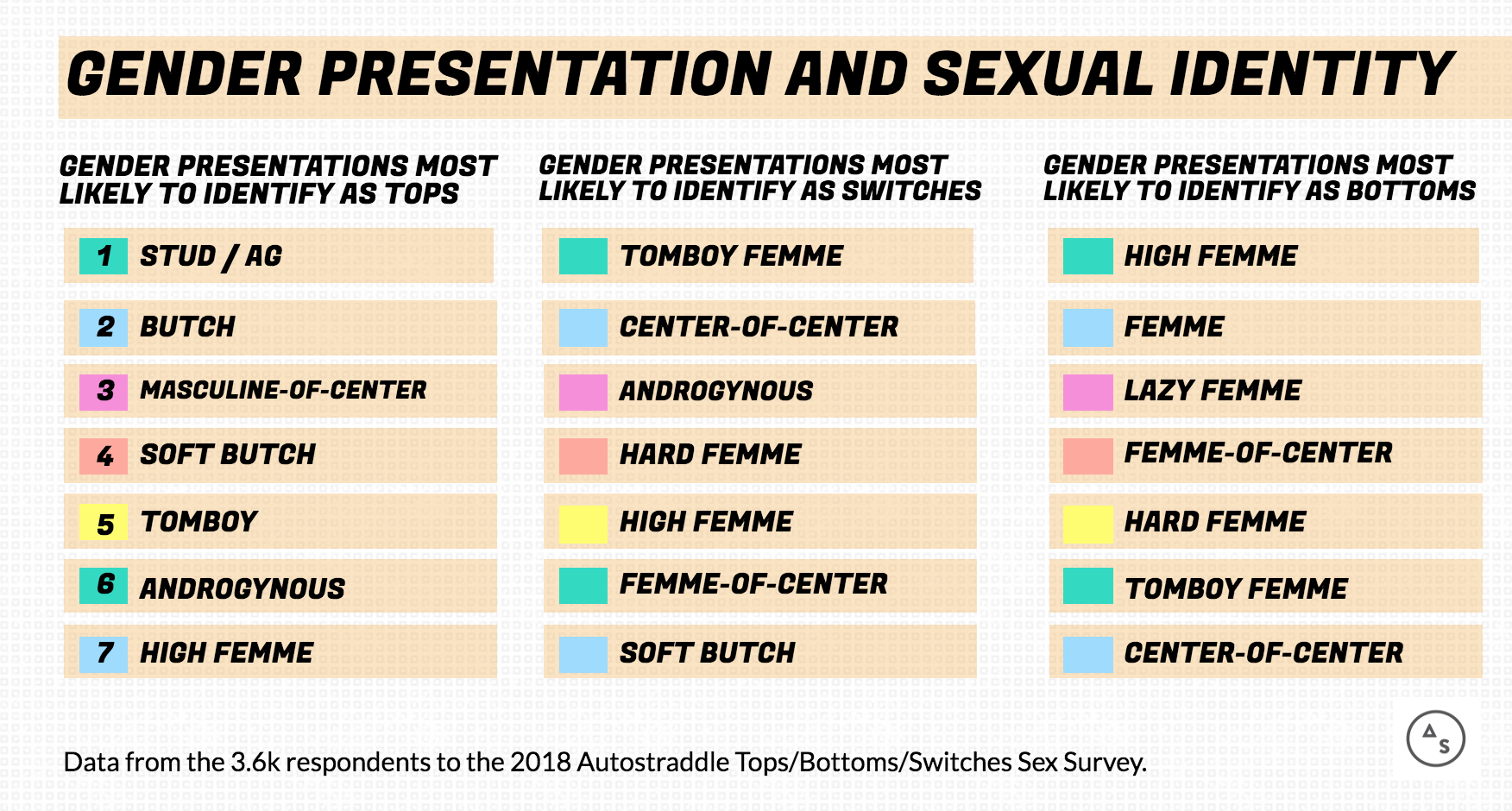
Back in the day, “butch” and “top” were considered inexorably linked, and that correlation remains common today, but it’s hardly universal or absolute. “Switch” was, as indicated in this post’s first chart, the most popular identification amongst our survey-takers, and that remains true when the data is segmented by gender presentation. A lot of survey-takers talked about enjoying a butch/femme = top/bottom dynamic in their sexual lives, but others expressed frustration about assumptions. “Often people assume I am more of a top,” wrote one self-identified versatile queer tomboy. “I have never had sex with someone who didn’t make an assumption that I would be dominant before they would. Tbh I think it’s because I’m hella butch. I also don’t get a lot of attention from other masc people. :-/”
“Previous femme partners have expected me to be more of a top based on being masculine-of-center, which is not what I prefer,” wrote one bottom-leaning switch.
“I’m a bisexual high femme,” wrote one survey-taker, “and I think this often translates into me being automatically perceived as a bottom, though I’m happiest being a switch most of the time.”
“I think at first I expected butch partners to be tops,” wrote one lesbian switch. “But that hasn’t really proven true and also ~surprise!~ I like being a top sometimes despite IDing as mostly femme!”
Some femmes talked about enjoying the subversion of gendered expectations within topping. “I STRONGLY identify as a Femme Top,” wrote one, “and bring many elements of that gender subversion into my dominance.” Another wrote, “I think my femme presentation allows for a lot of power and gender play in my role as a domme.”
How masculine/feminine energies and presentations actually play out in bed and attraction — including the impact of dysphoria on sex — is a larger topic for a later post. Y’all shared so many stories on this topic that I’m eager to discuss! But this post is already very long, so I will set you free upon the world at this time.
In conclusion, one time a cis man paid me to kick him in the balls for ten minutes and it was the easiest $160 I’ve ever made.
C U Next Tuesday to talk about switches and people who don’t identify as tops or bottoms!
Lesbian Sex 101 is Autostraddle’s series on how to have lesbian sex for queer women and anyone who finds this information applicable to their bodies or sexual activities. Employment of the term “lesbian sex” in this post uses “lesbian” as an adjective to describe sex between two women or people who identify with that experience, regardless of the sexual orientation of the two people involved.
Sex ed almost never includes queer women or our experiences, so we’re exploring pleasure, safety, relationships and more to make that information more accessible.
A lot of the language in these posts is intended to make them easy to find on search engines.Some of the body parts we talk about will be yours or your partners’ and some won’t. Some of the pronouns will be yours or your partners’ and some won’t. Some of the sexualities will be yours or your partners’ and some won’t. Some of the language will be yours or your partners’ and some won’t. Take what you want and what applies to you or what you can make apply to you and your partners and your experiences, and leave the rest!
Tops, Bottoms, Switches, What Do You Mean: Take Our Autostraddle Lesbian & Queer Sex Survey
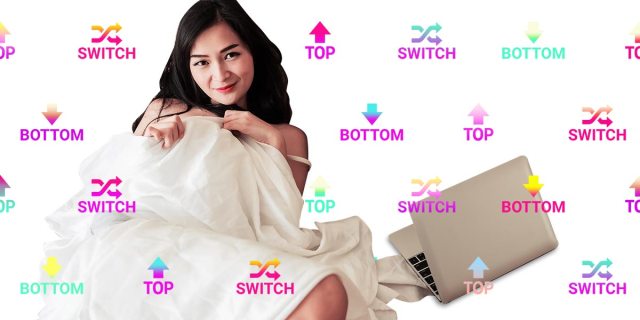
Writing this week’s “Lesbian Sex 101” post, the first in a three-week series about defining commonly used terms like “top,” “bottom,” “switch,” “submissive” and “dominant” (and their small variations wherein) was … challenging. I declared, at various points in my journey, “nothing means anything anymore!” and “everybody thinks everything means something different!” Through research and extensive personal crowdsourcing, I was pretty close to wrapping up the post about bottoms and submissives when it occurred to me that I’d love to be able to include DATA from y’all about it. It seems like these days, most queer women and non-binary people identify as tops, bottoms or switches but within this specific community there is not a consensus on what we mean when we say those words.
Thus, we come to you bearing a sex survey. We’re looking here specifically at the dynamics that occur in sexual activities that involve people who are LGBQ+ women (cis or trans) or else non-binary people or trans men who feel an affiliation with queer women’s communities. We recognize that this is an imperfect description of a community, but this is a very complicated community and it’s very hard to nail things down and get good data. Please note that most of these questions are referring to sex and sexual dynamics between people who are not cis men — not because bisexual women in relationships with men are not queer enough to be here (you are!) but because that’s just not the topic of this particular survey or this series. Anybody who is not a cis man and has slept with people who are not cis men at any point are welcome to take this survey if it feels relevant to your experiences. Okay. Please don’t yell at us today, we’re very understaffed, we can’t make edits to the survey once it’s live without re-routing everybody to the top of it and erasing their answers, the world is on fire and it’s very hot in this laundromat. Sex is fun!